GALWAY AND MAYO'S
FANTASTIC FANLIGHTS
AT THE EDGE:
An armchair tour by Nessa Roche and Damian Murphy, Built Heritage,
Department of Housing, Local Government and Heritage
What is a fanlight and why are they so interesting that they deserve inclusion in Architecture at the Edge? This festival is about boundaries. Doorways are boundaries between public and private spaces. They proclaim the building to outsiders and are the route to shelter inside. Doorways are often embellished to make an architectural statement about power or use or accessibility. We often note pediments and porticos but the details of fanlights and sidelights have not received as much attention. This article helps to bring alive the contribution of these delicate delights to our cultural heritage.
A fanlight is any over-door light purposefully designed to be a decorative feature using at least three panes. The term covers everything from mouth-organ squares looking like a row of teeth to semi-circles of wildly ornate artistic flourishes. Fanlights are usually thought of as arched with spokes in a fan shape but there are also plenty of rectangular ones. We hope this tour will illustrate very clearly that these fantastic Galway and Mayo fanlights are important aspects of our architectural heritage.
This virtual tour of the fanlights of Galway and Mayo aims to introduce all types of fanlights from the ordinary to the extraordinary in all kinds of settings, including churches, convents, old schools and shops. Ireland has a tremendous heritage of fanlights of many shapes and makes, in wonderful doorcases ornamented with Classical and Gothic design details. Fanlights are enduring proof of the creativity of Irish architects and joiners over a period of nearly two centuries, from the early eighteenth century to the end of the nineteenth century.
The Fantastic Irish Fanlights Armchair Tour started with a series of articles on fanlight periods, designers and makers, materials and design families, before it took to the road. You can access these explanatory articles via the website of the National Inventory of Architectural Heritage (NIAH).
All of the images here are from the NIAH, unless otherwise specified, and we would like to thank the owners of the properties for allowing us to photograph their fanlights. Please note that the majority of the properties on this virtual tour are in private ownership and are not open to the public.
Fanlights of Galway
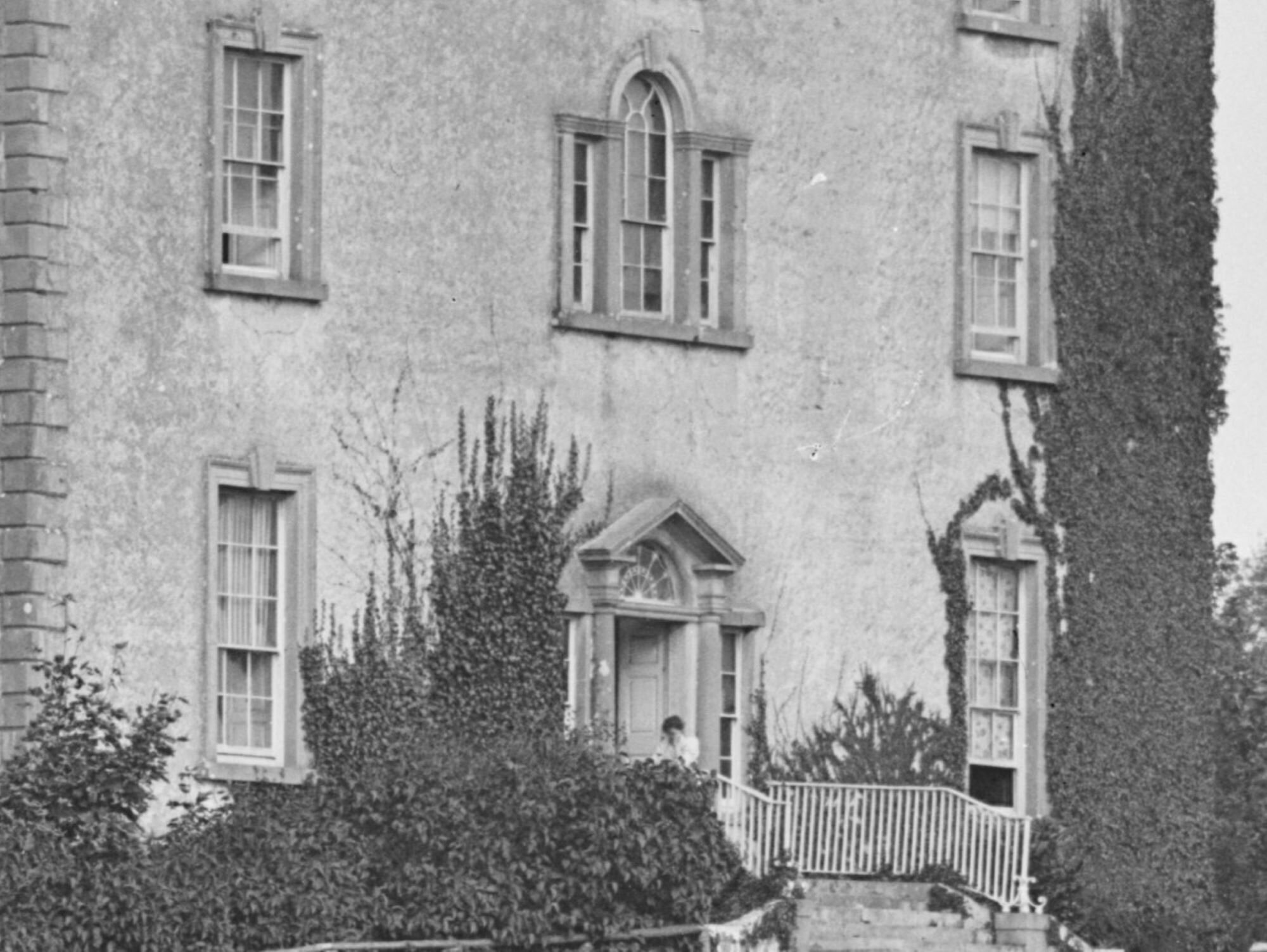
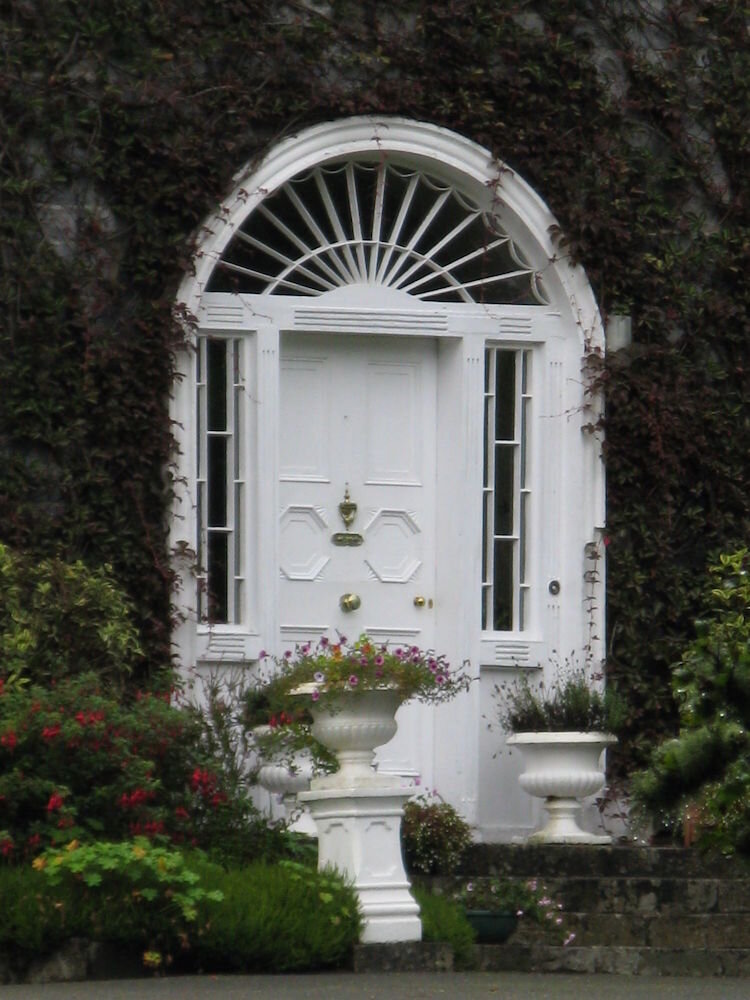
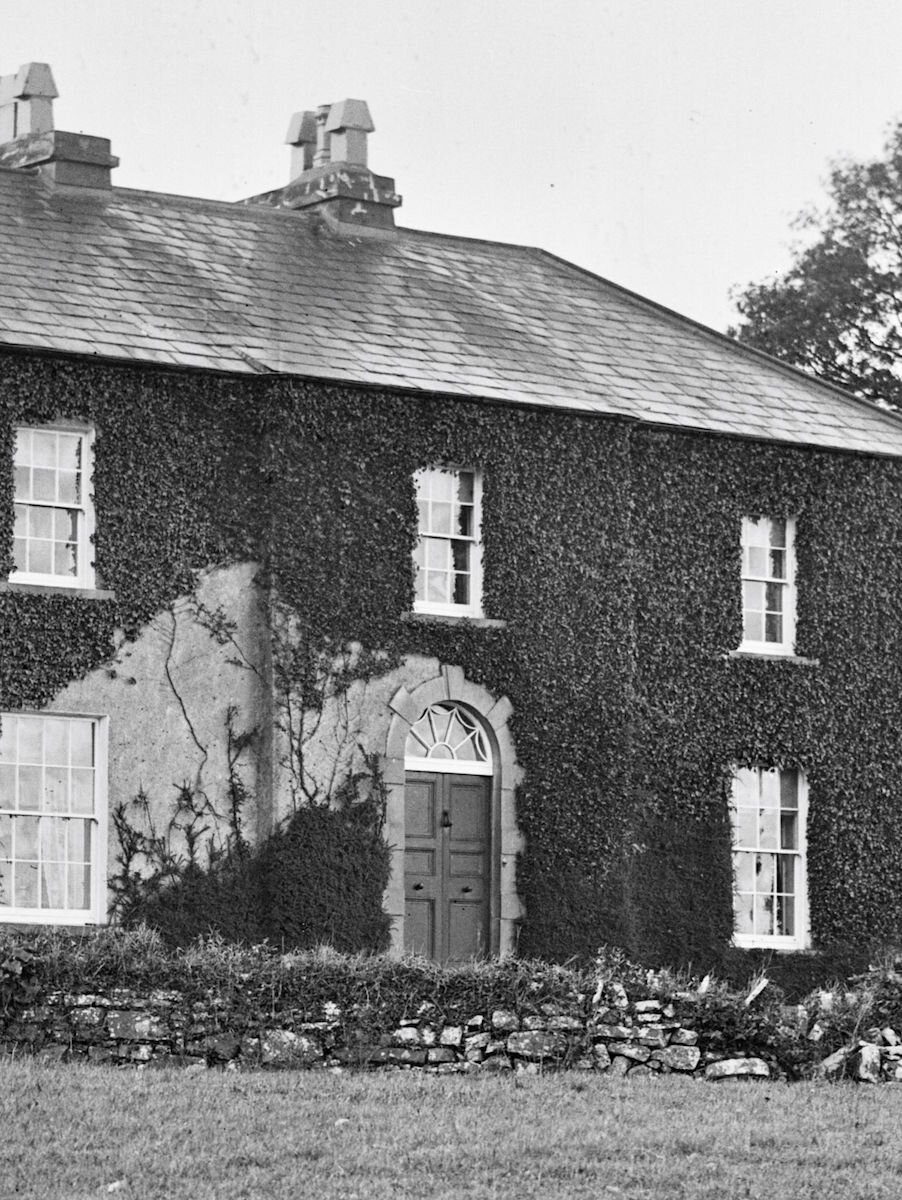
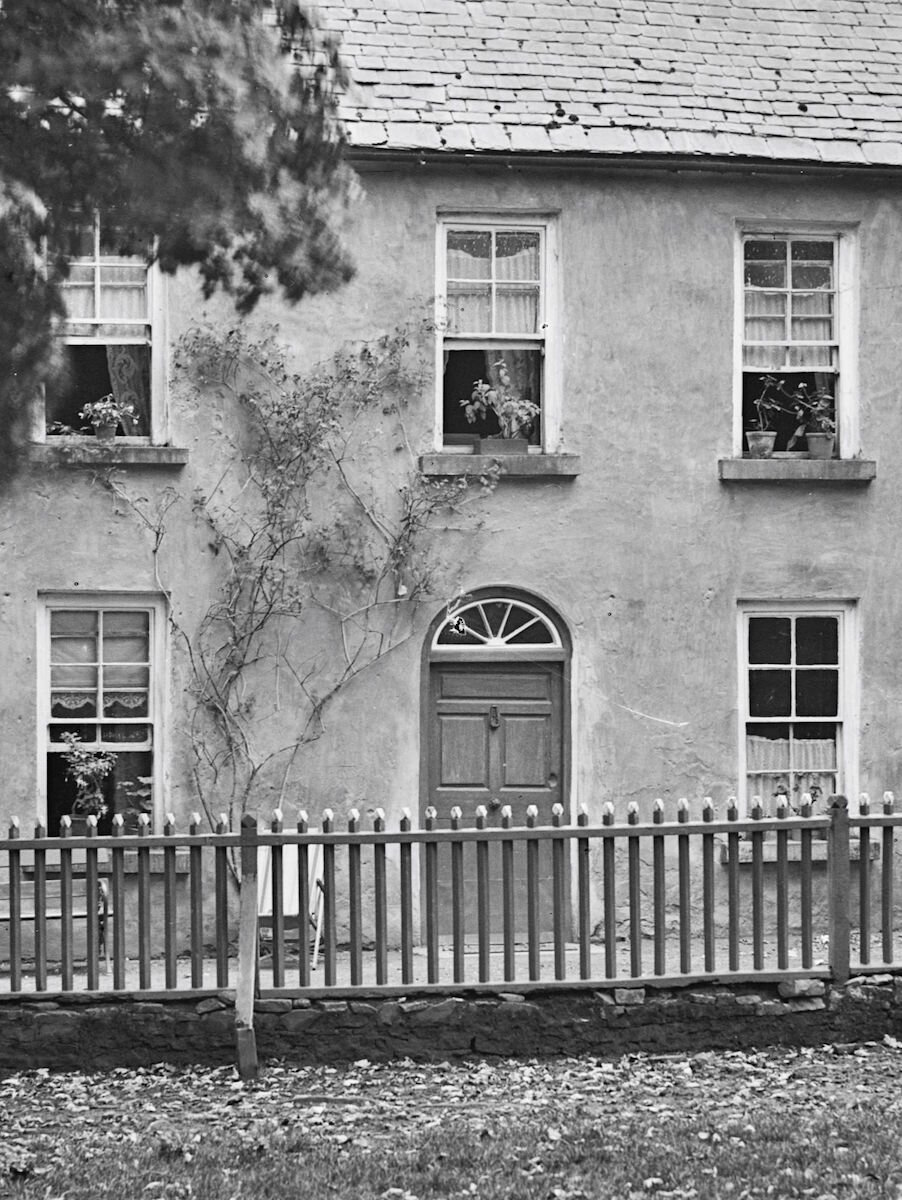
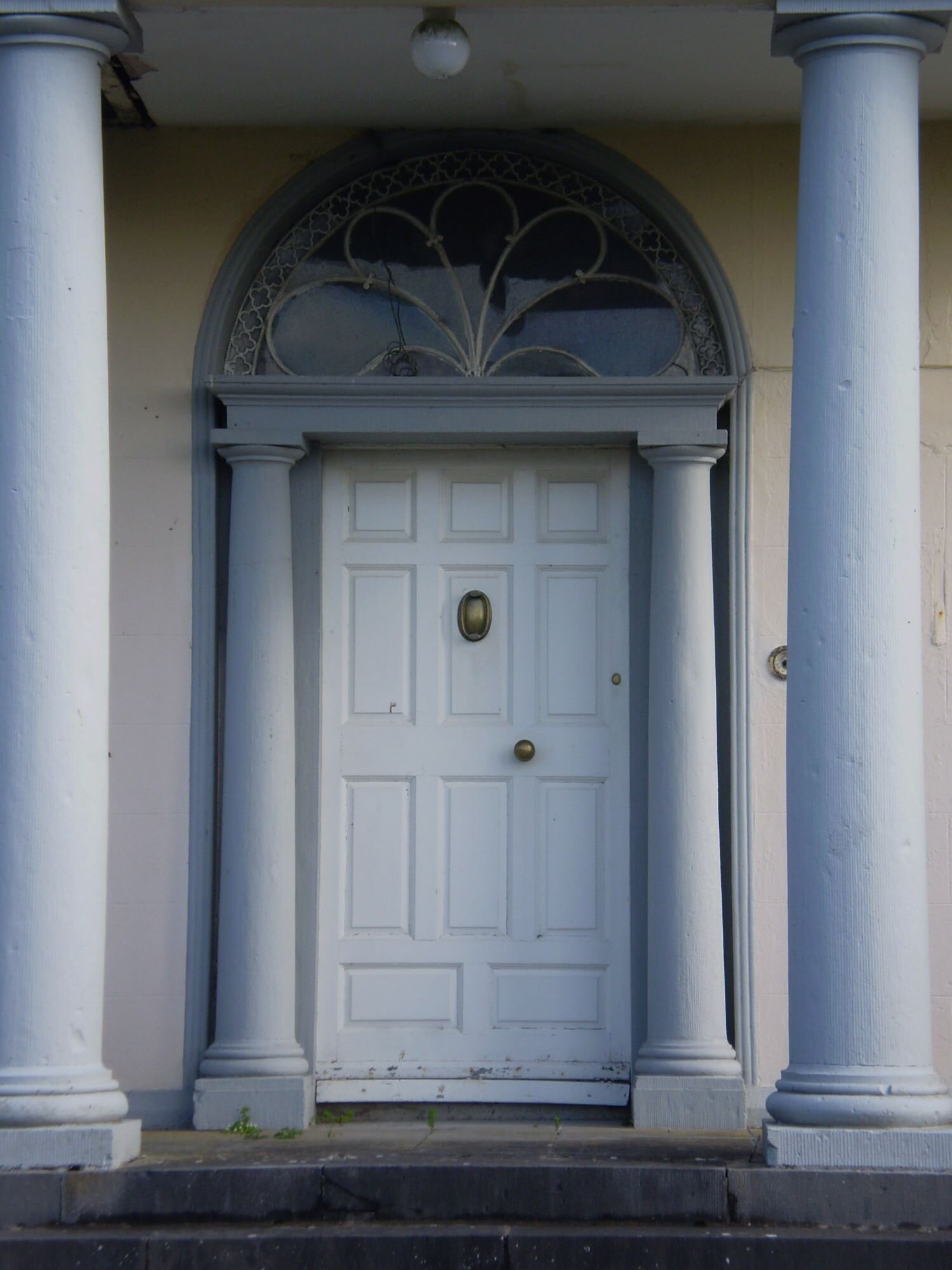
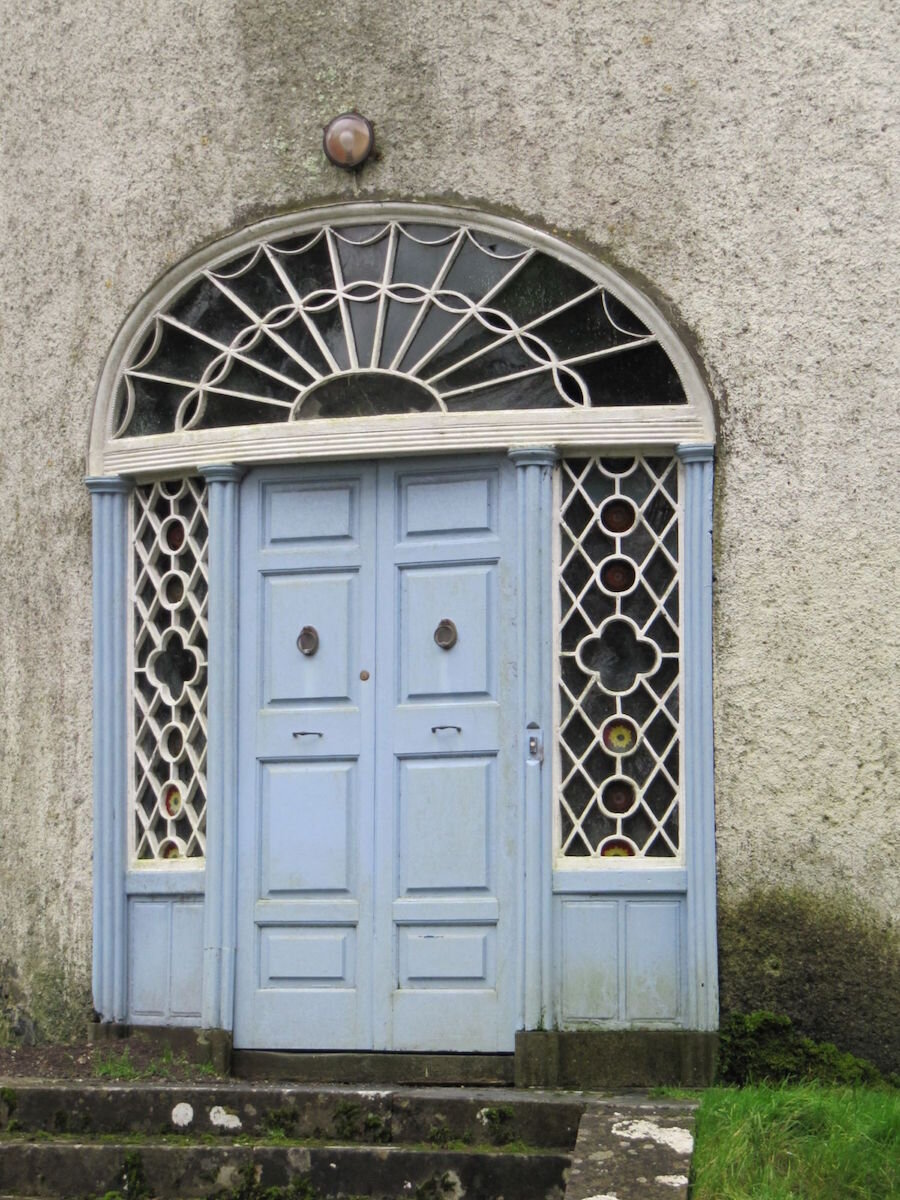
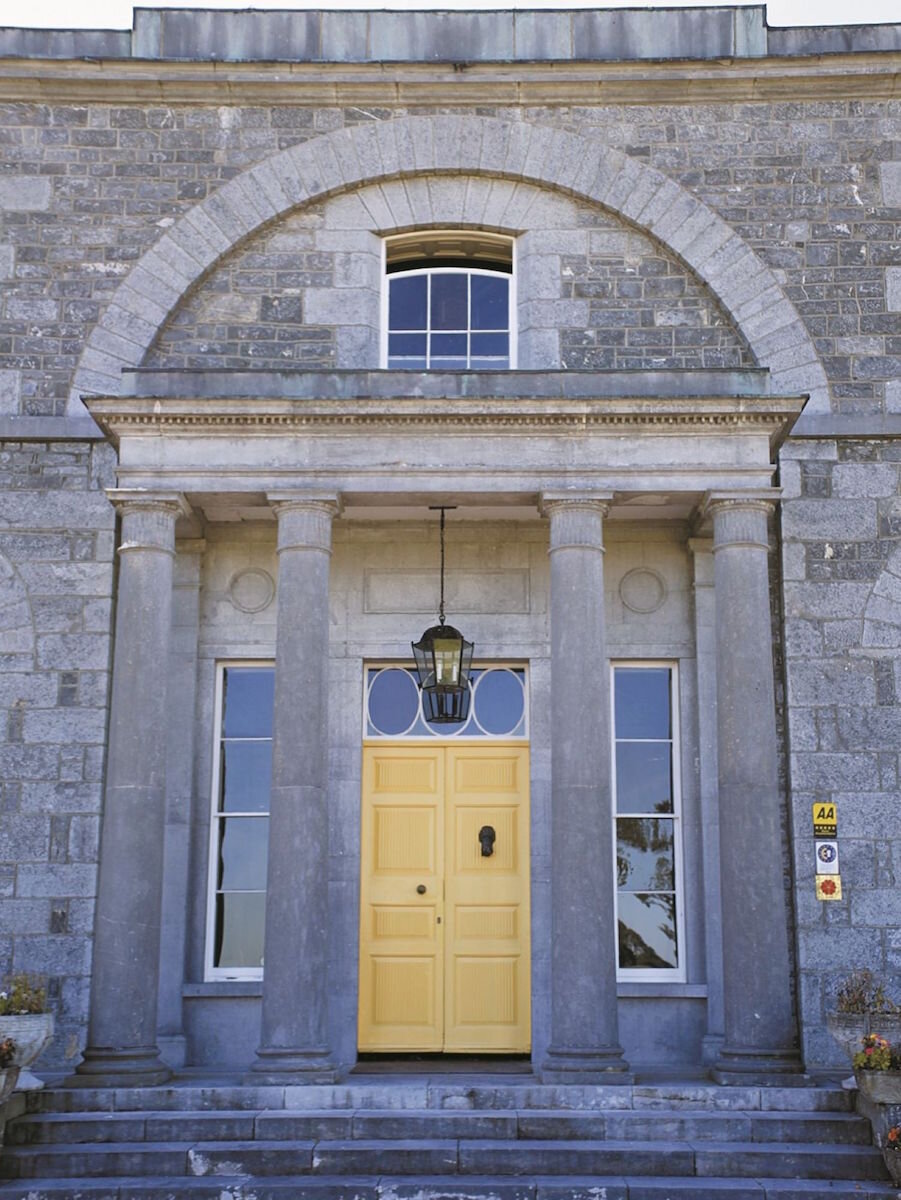
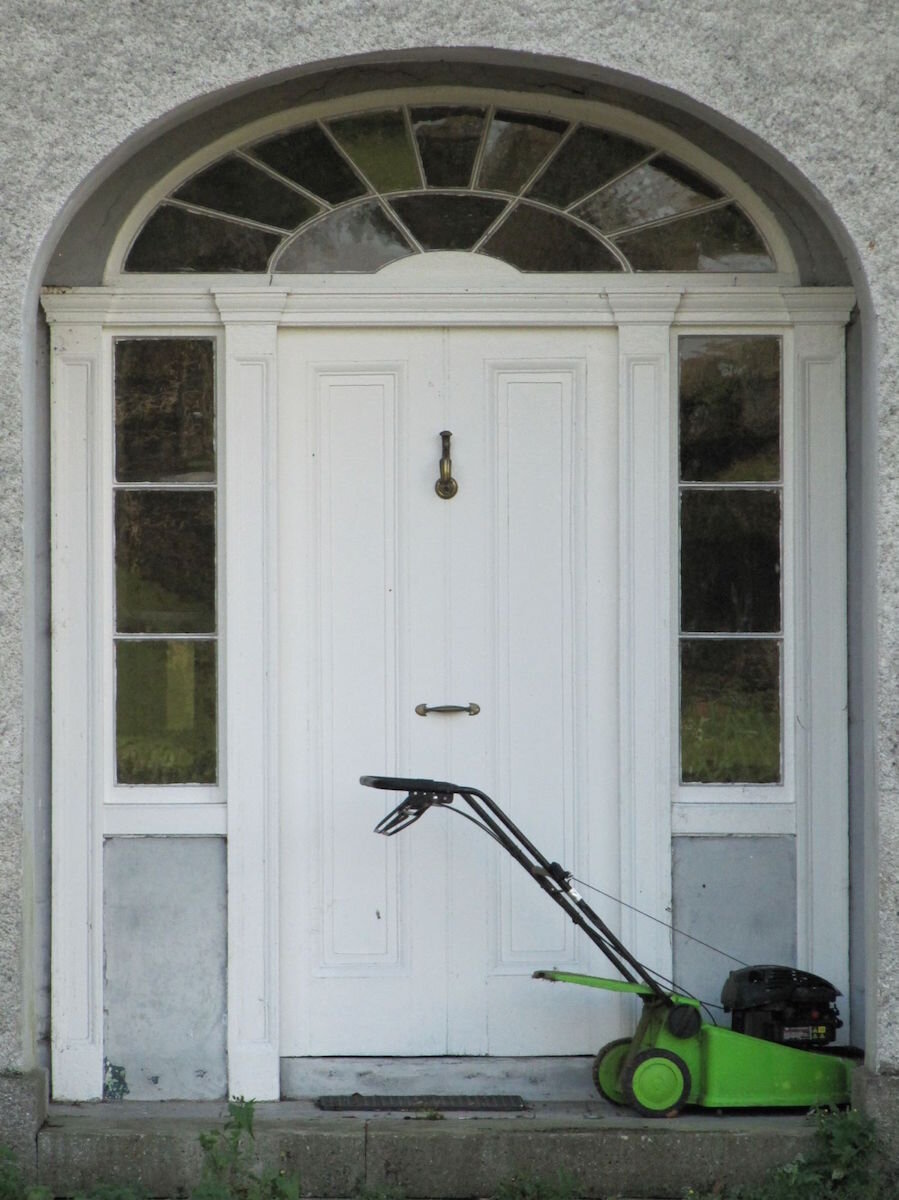
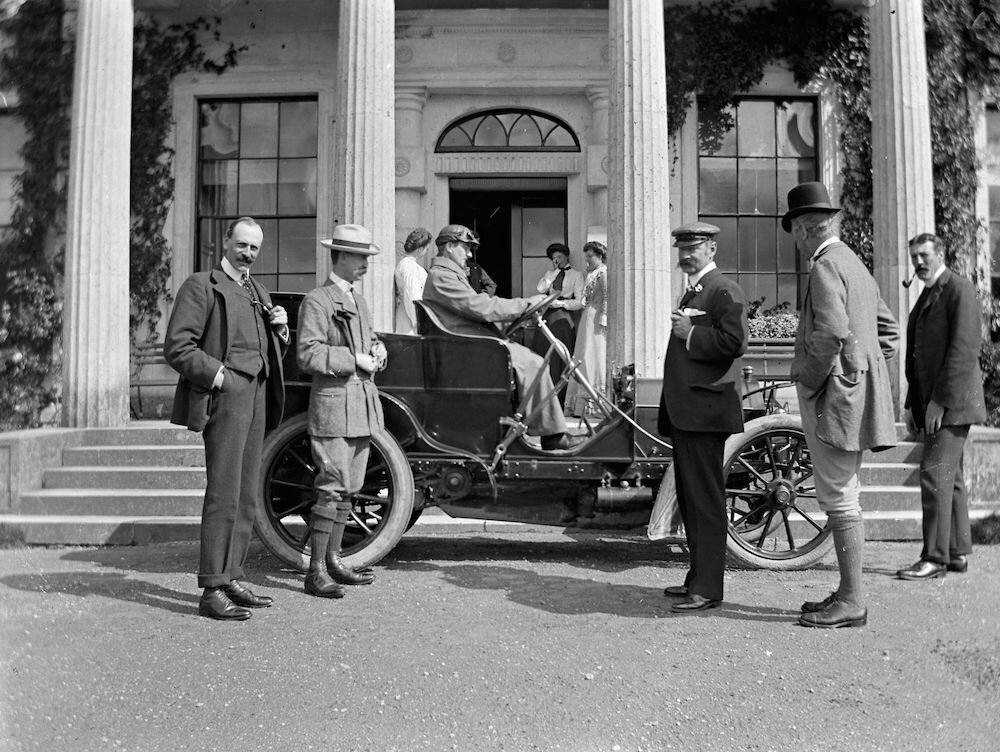
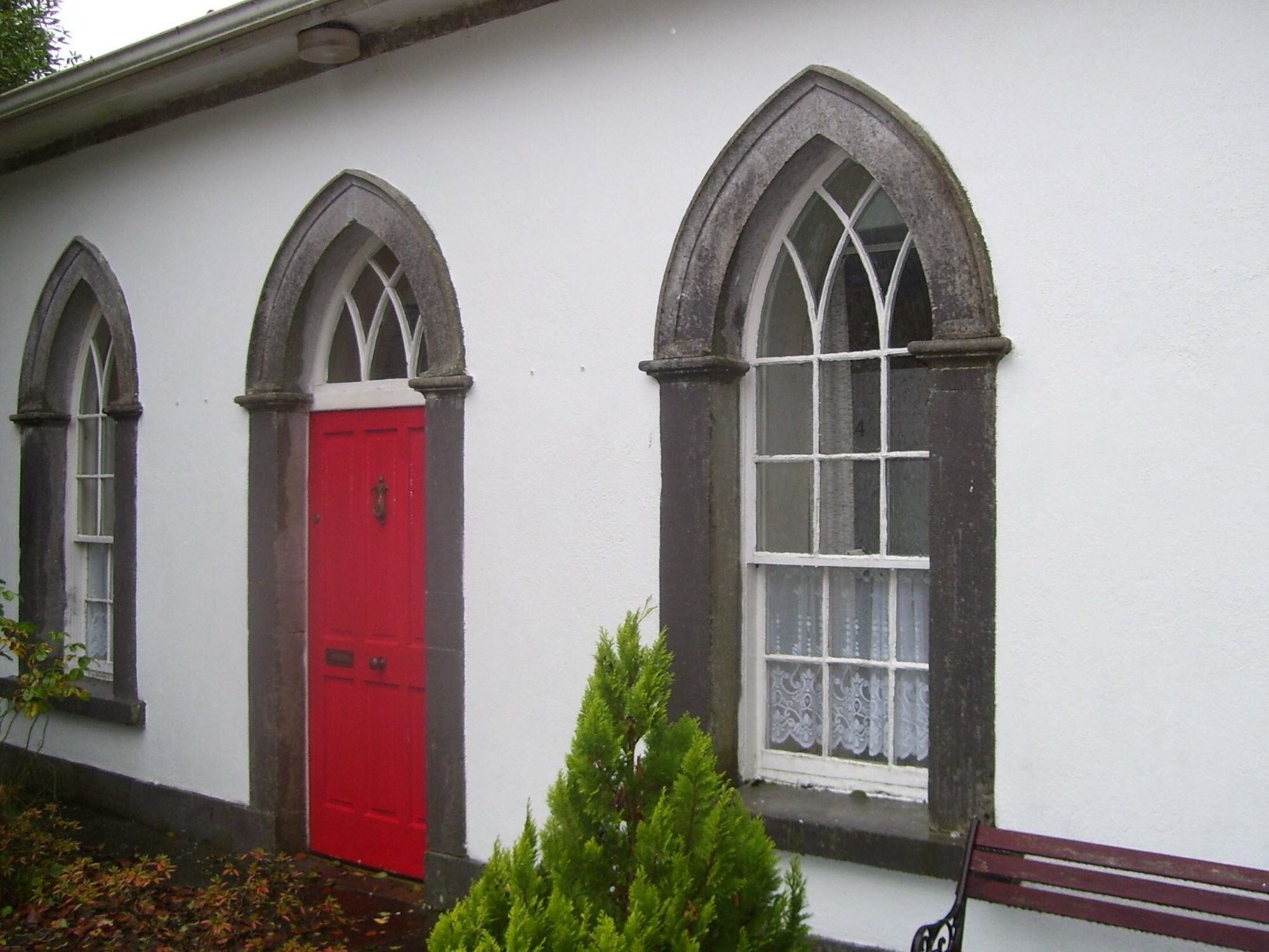
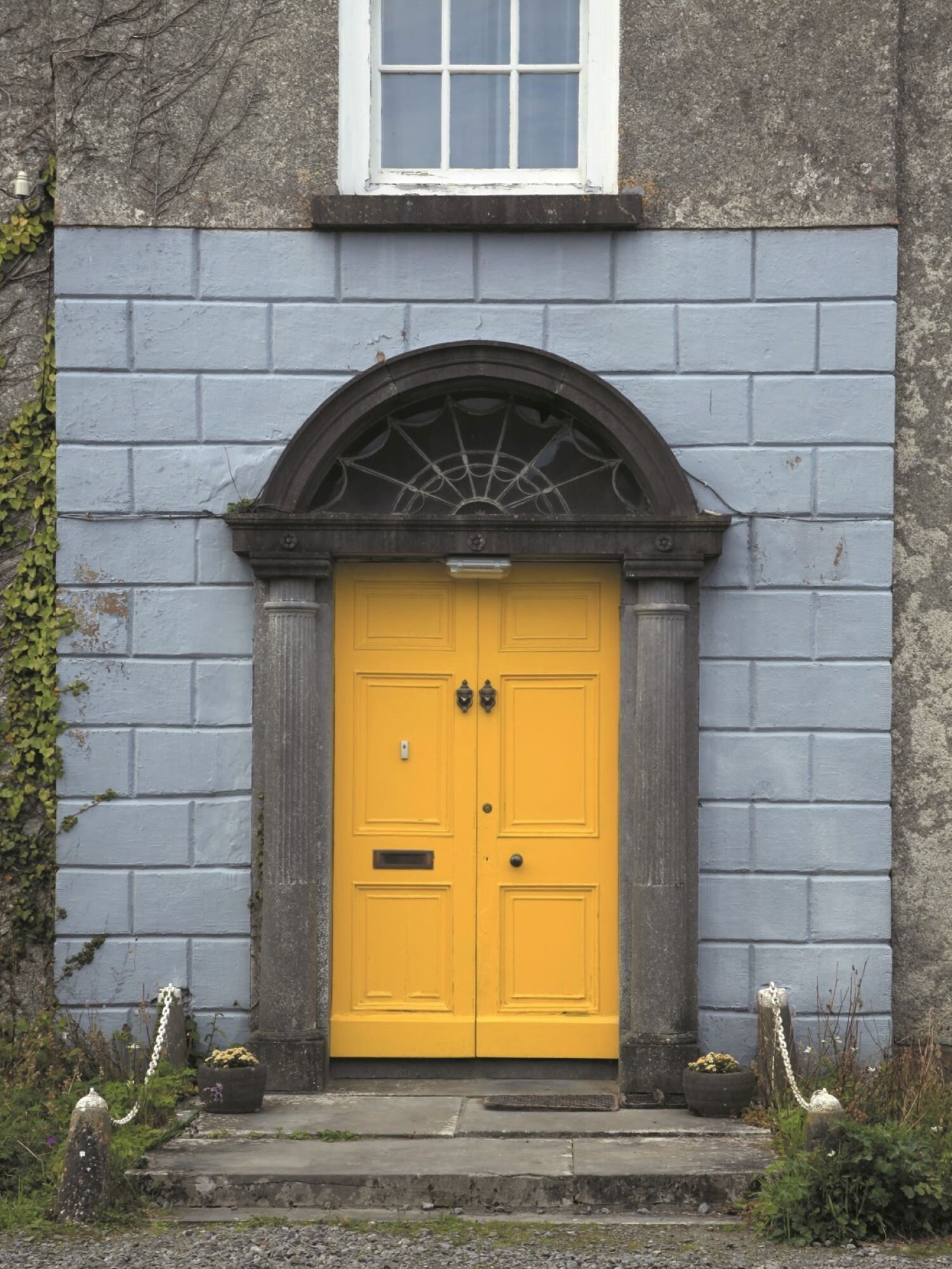
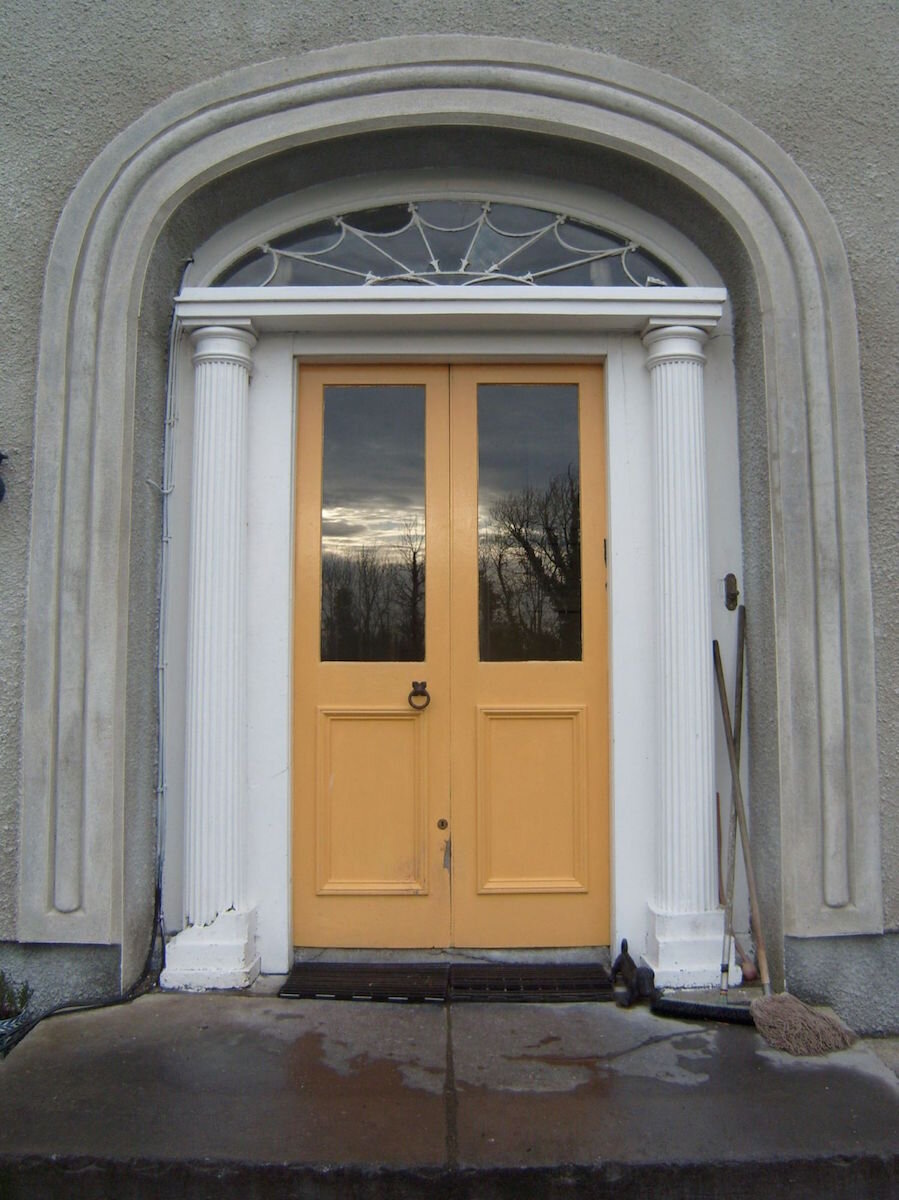

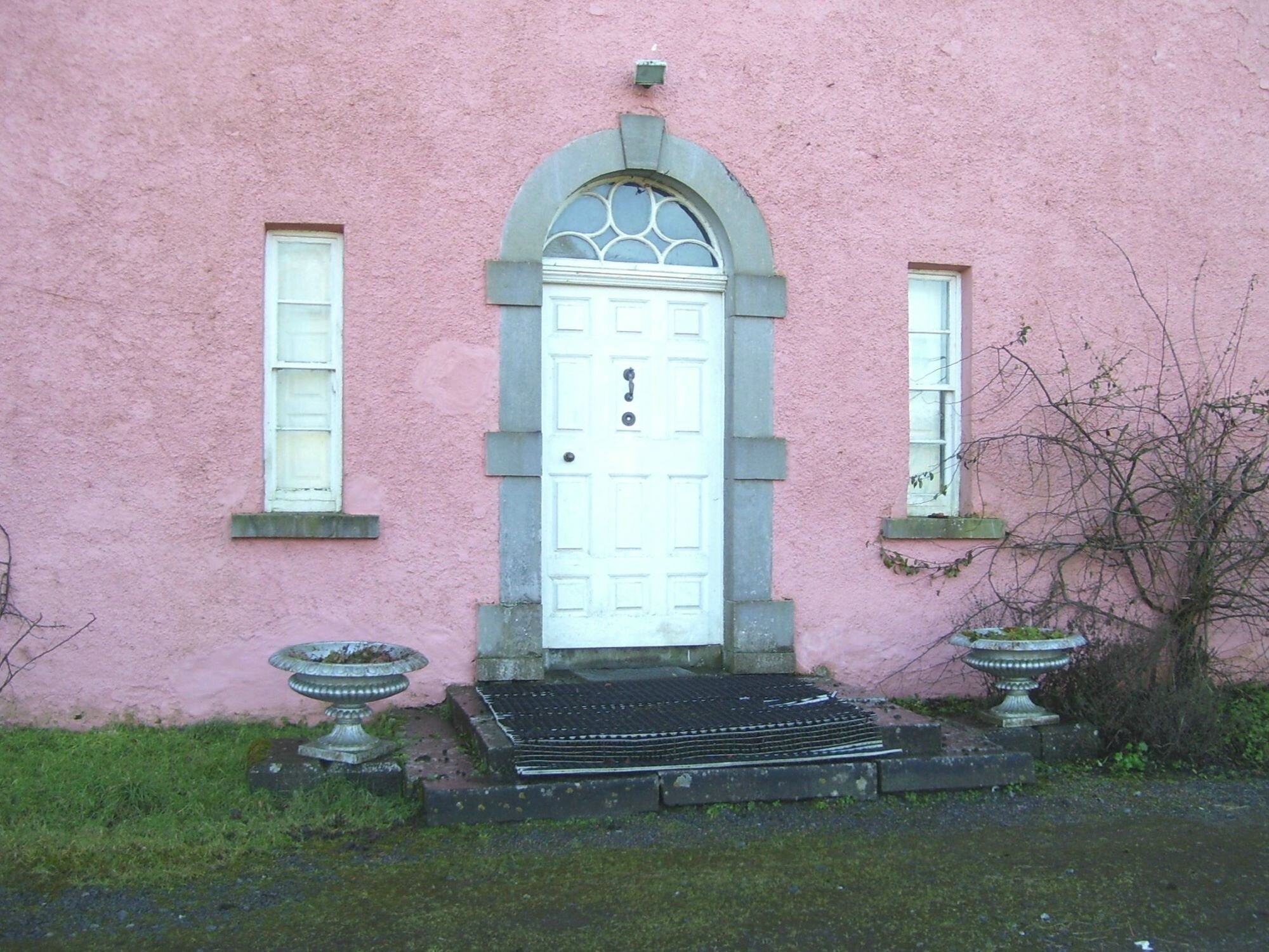
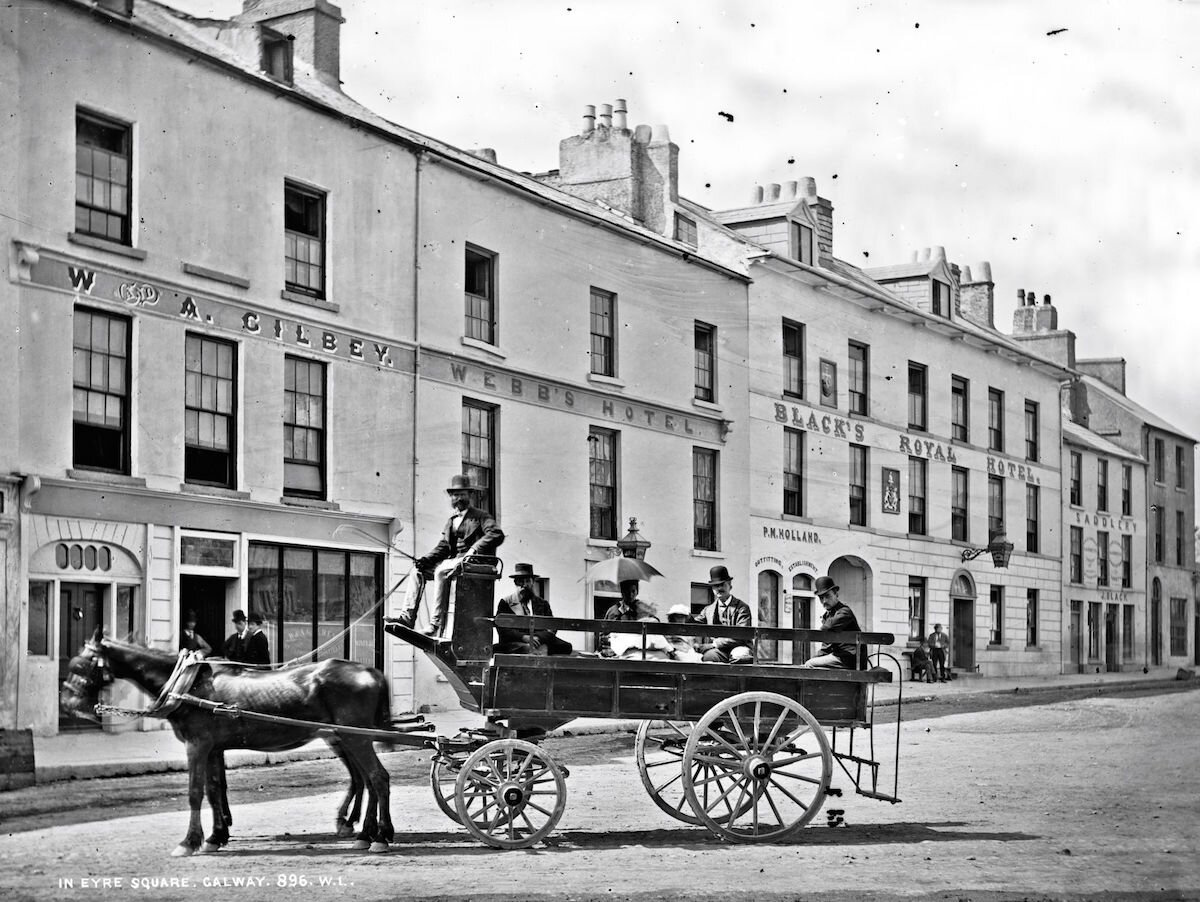
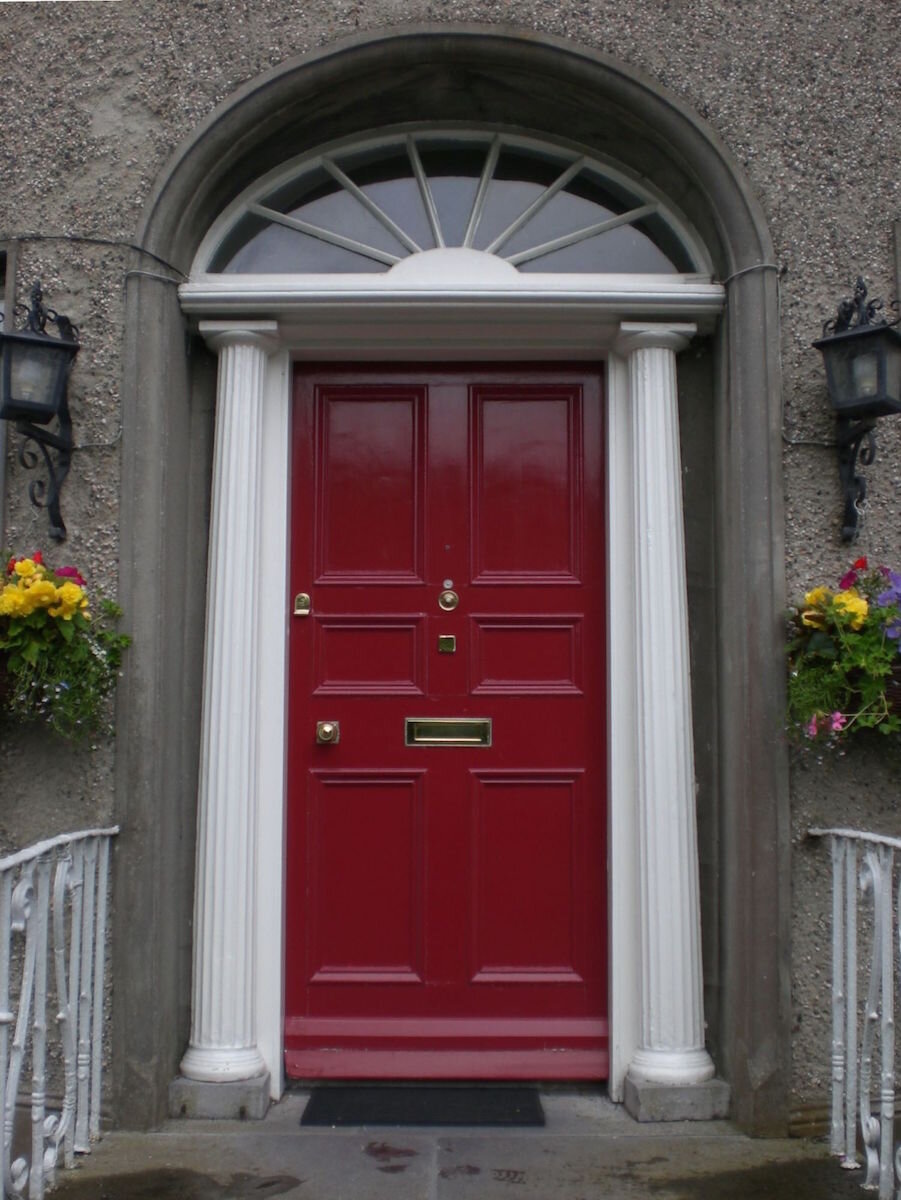

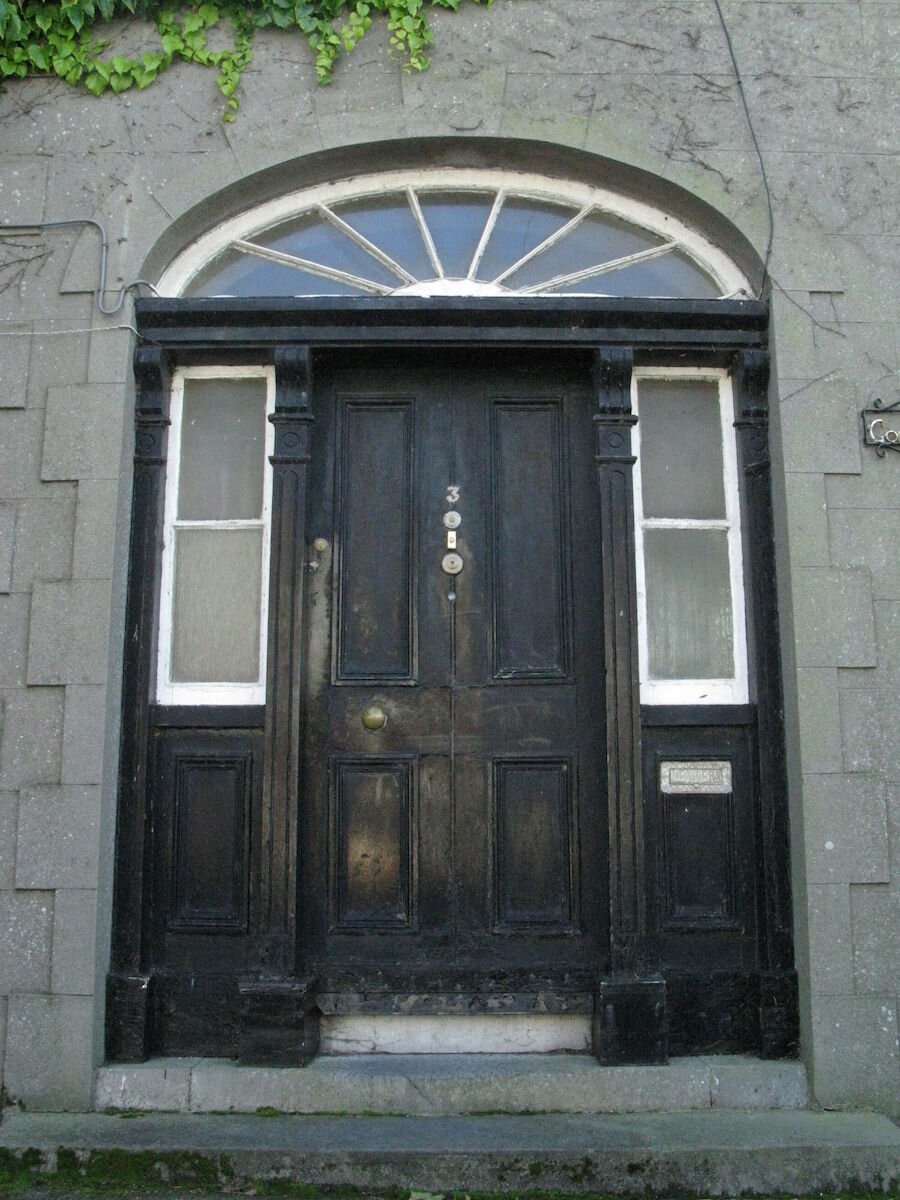
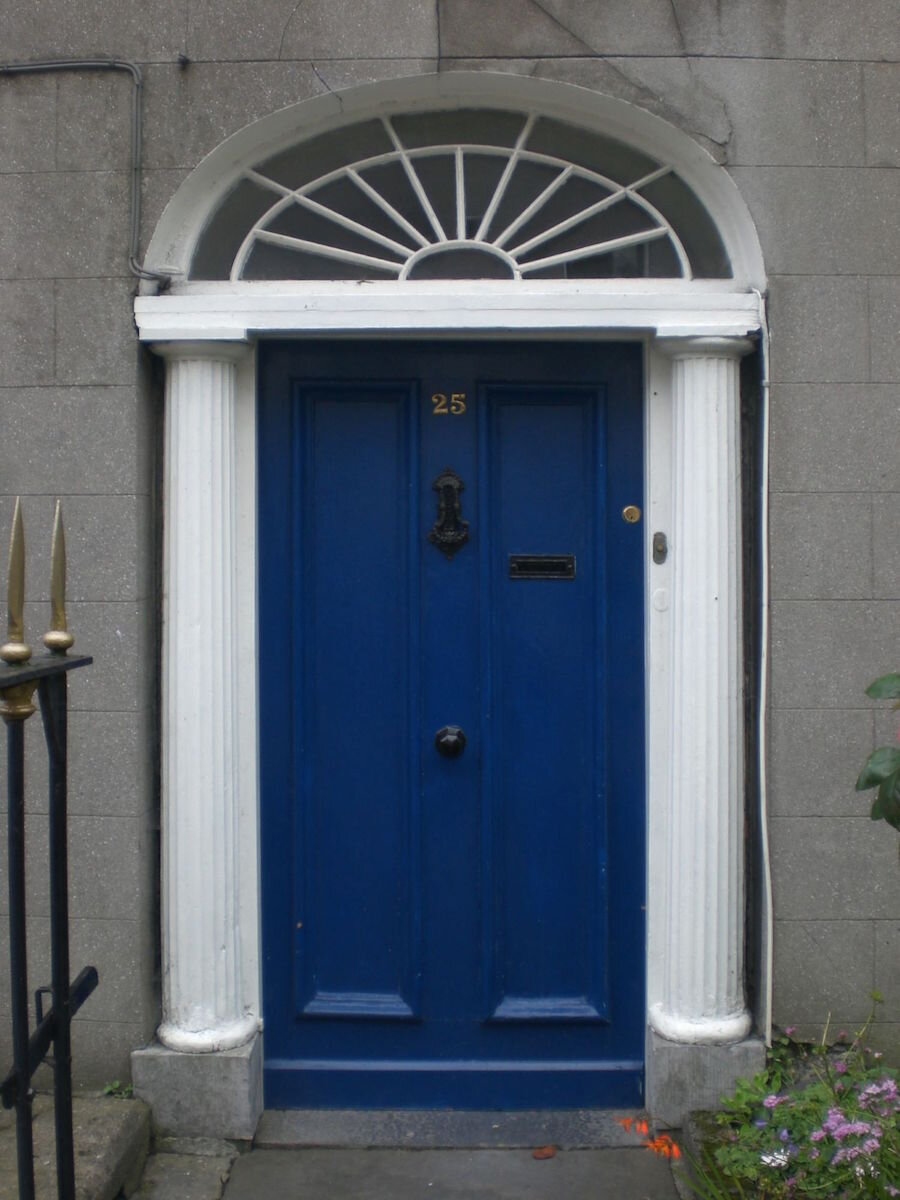
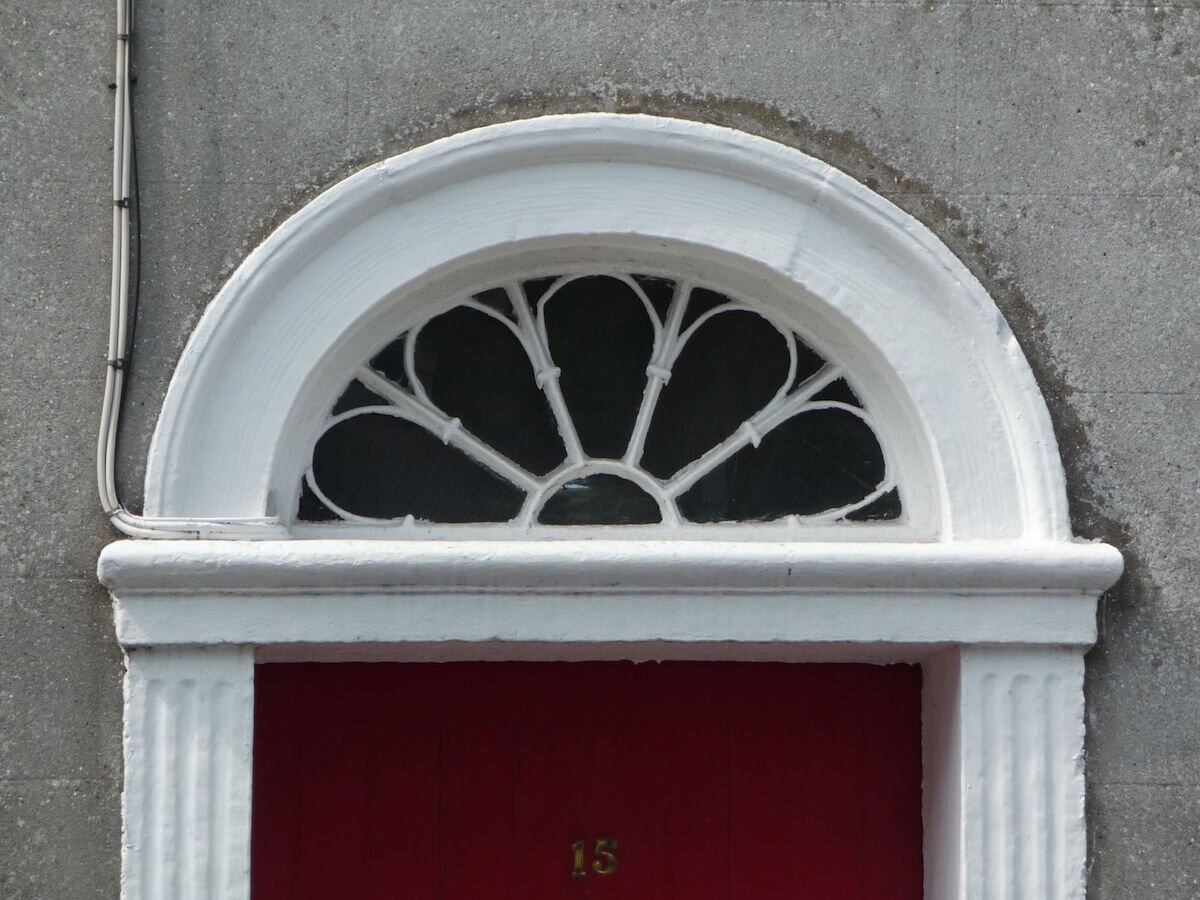
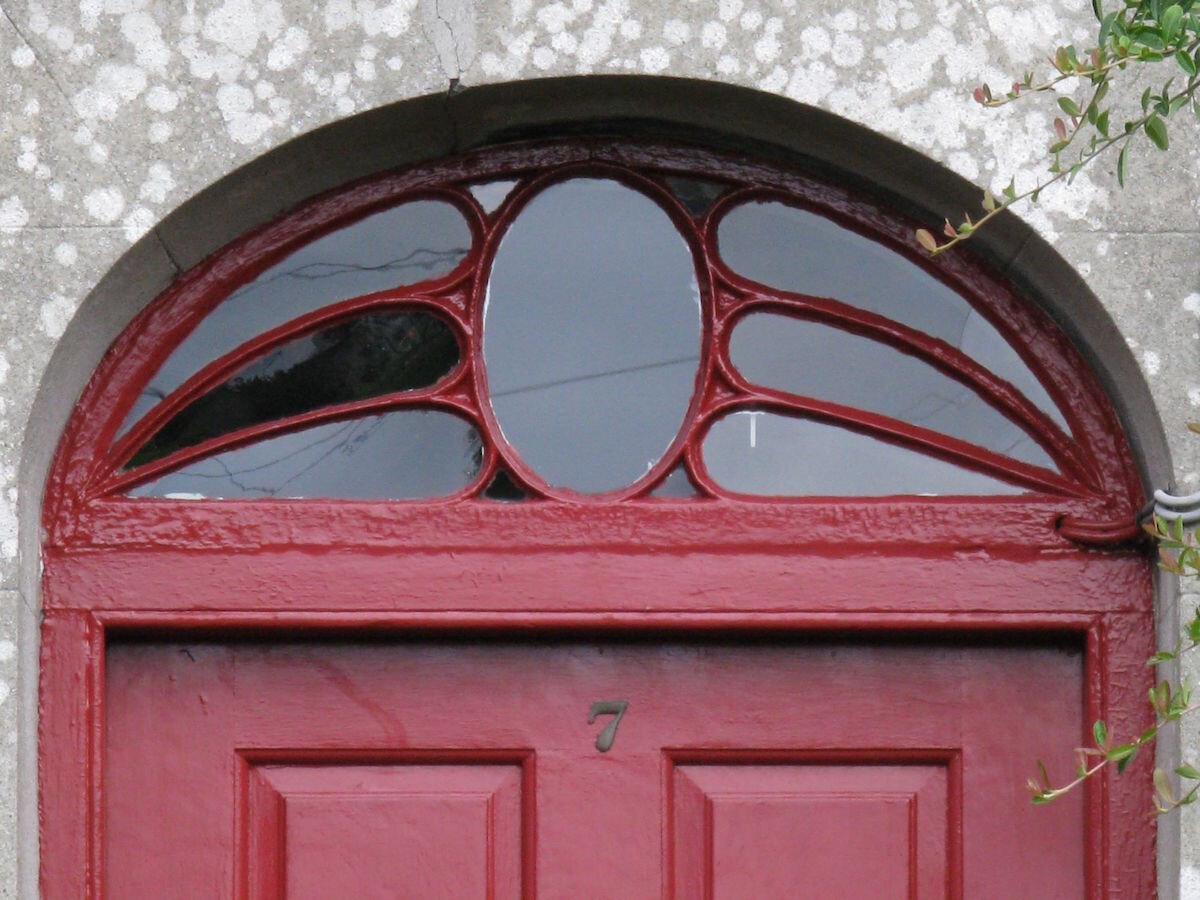

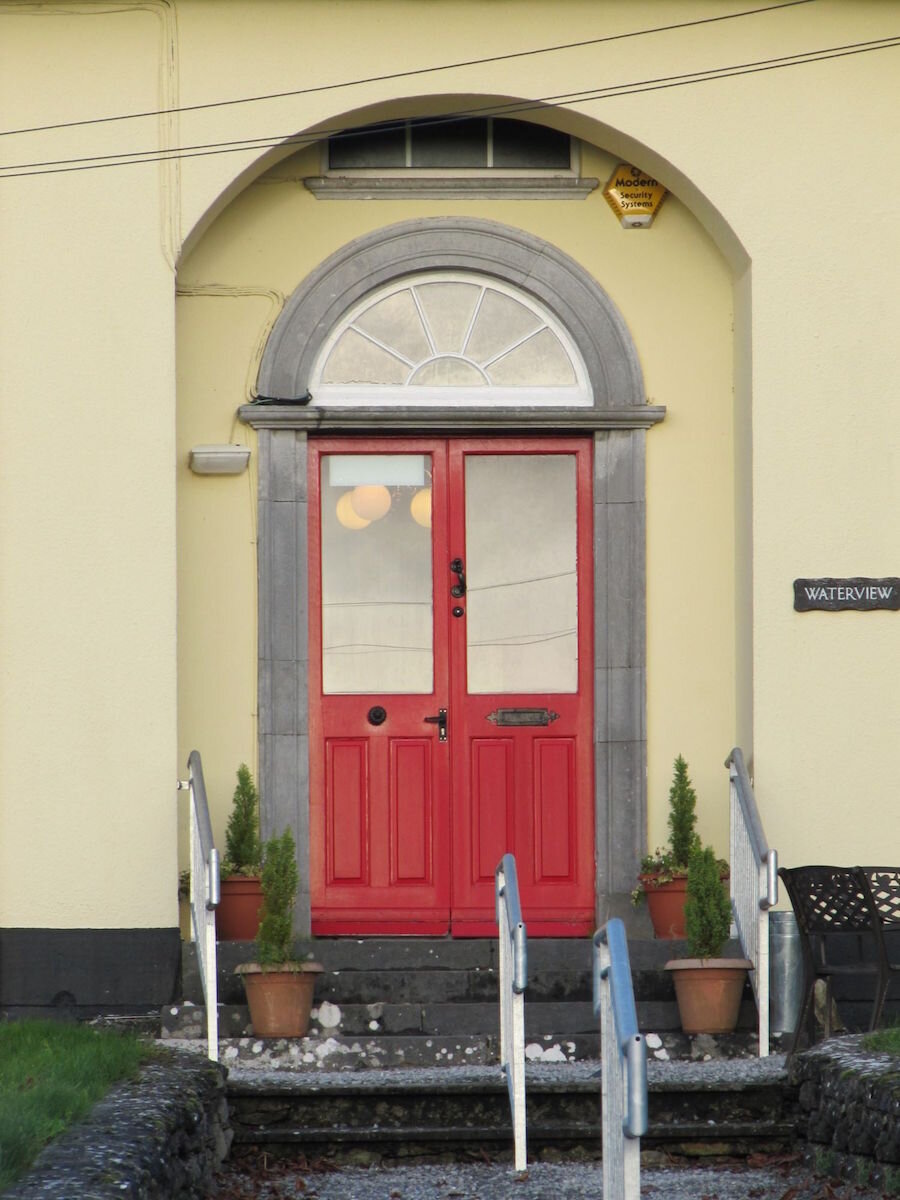
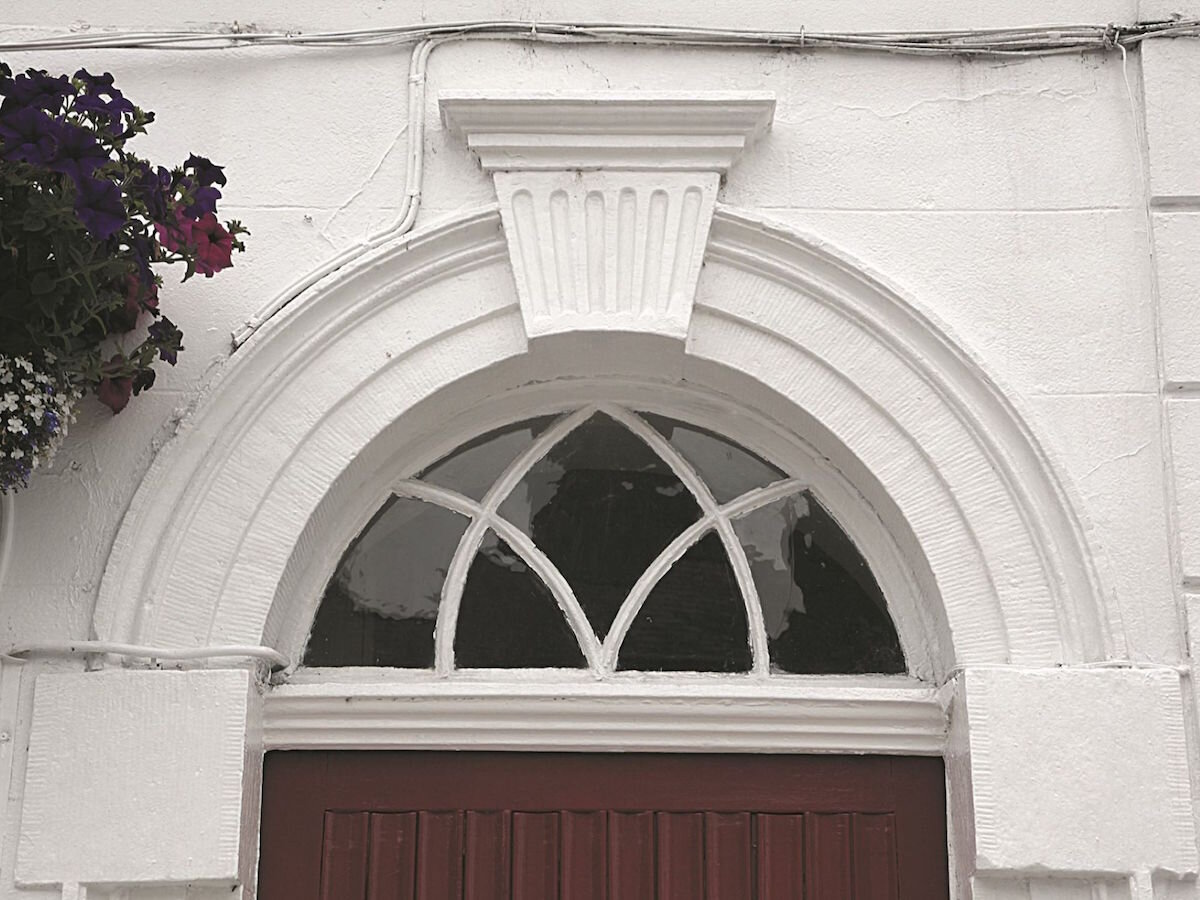
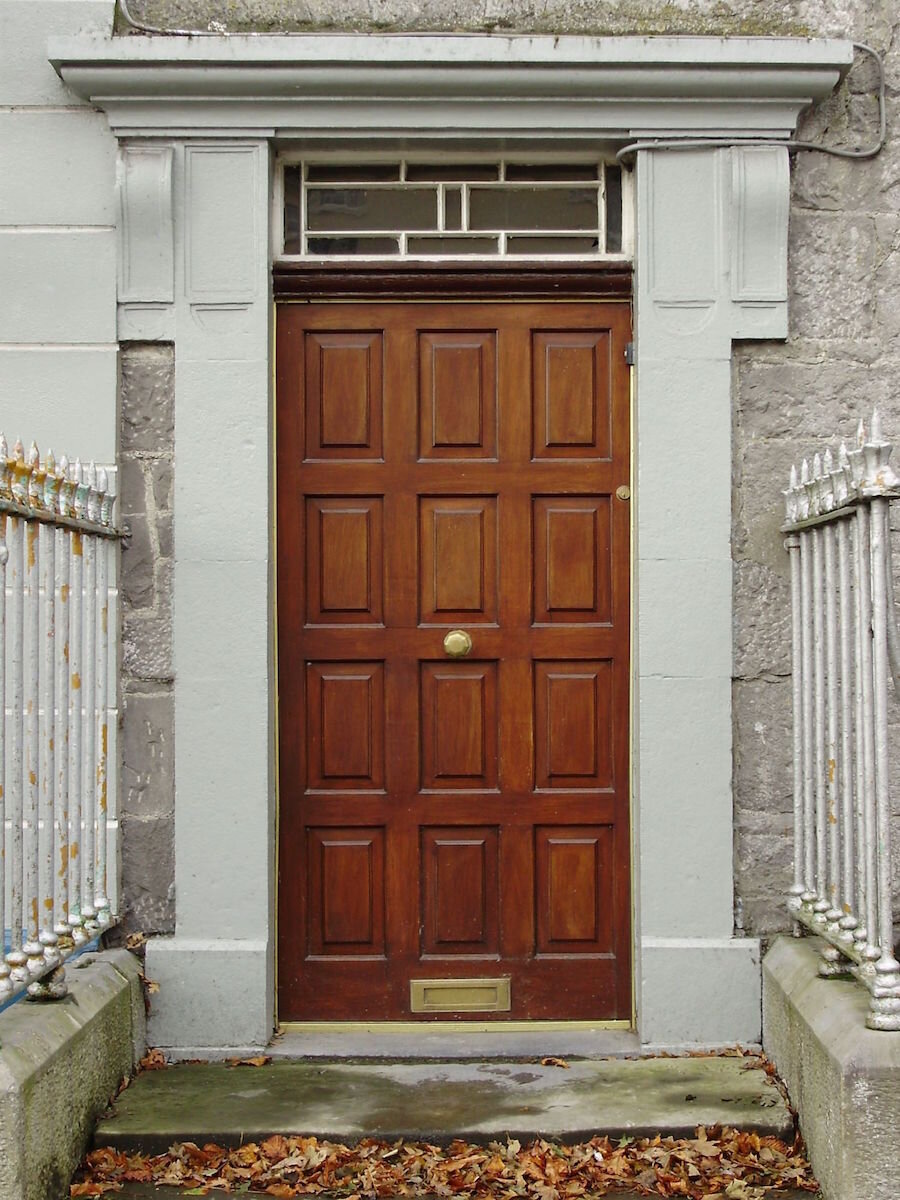
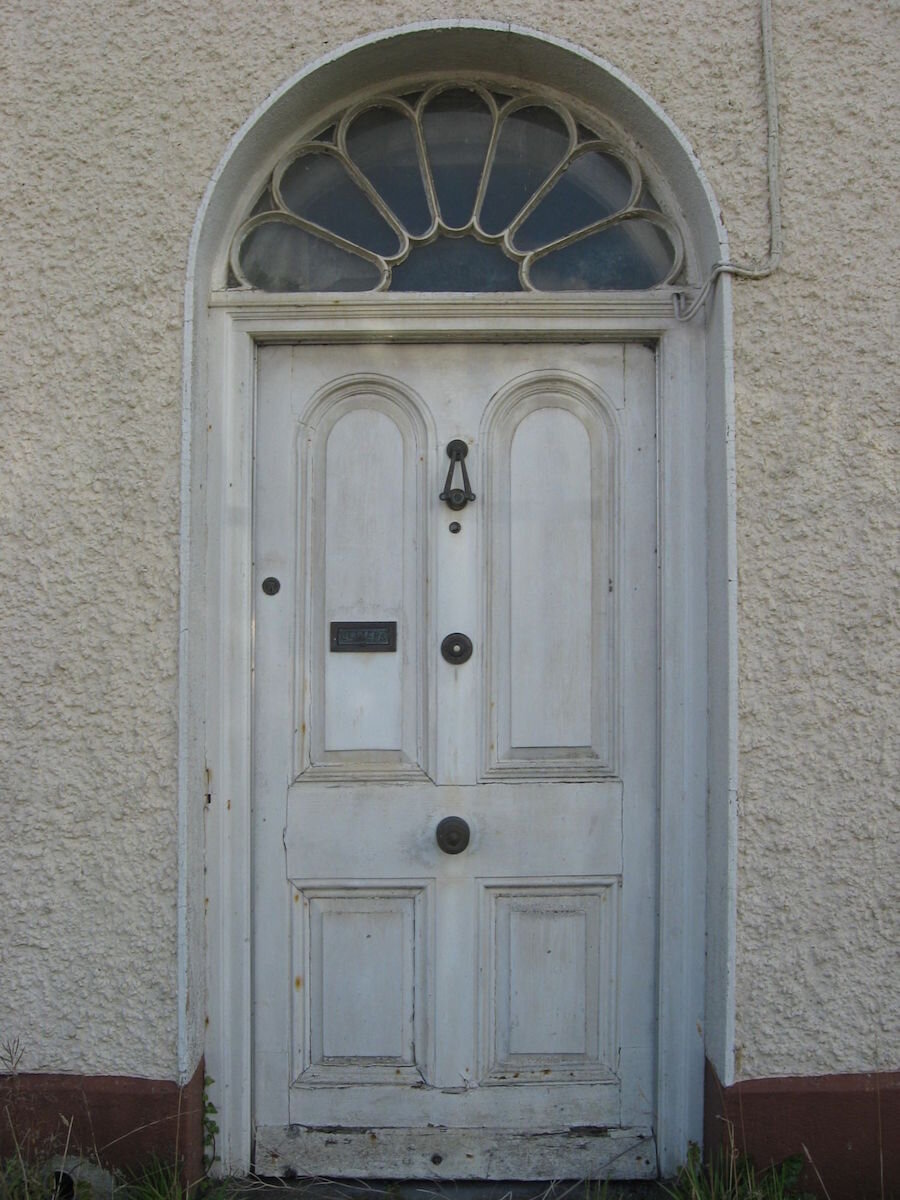
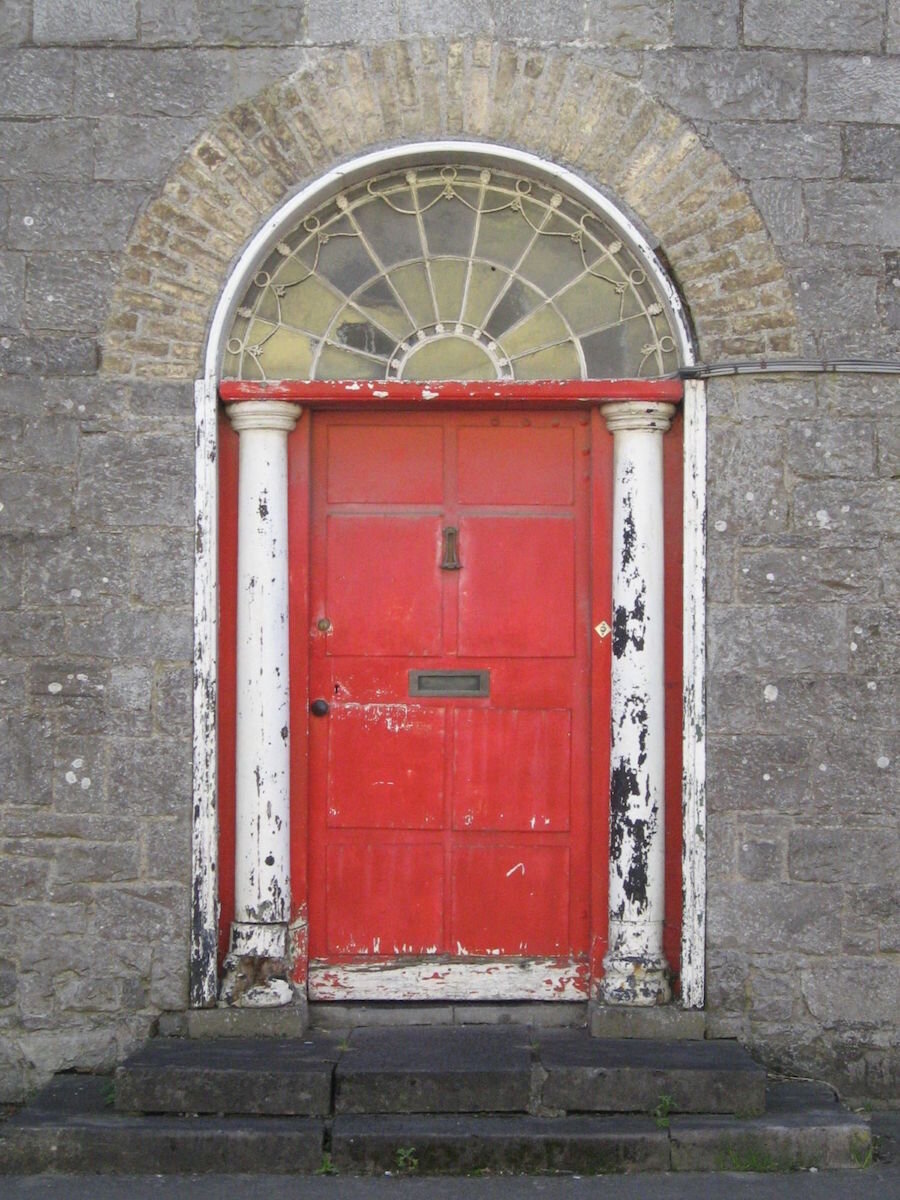
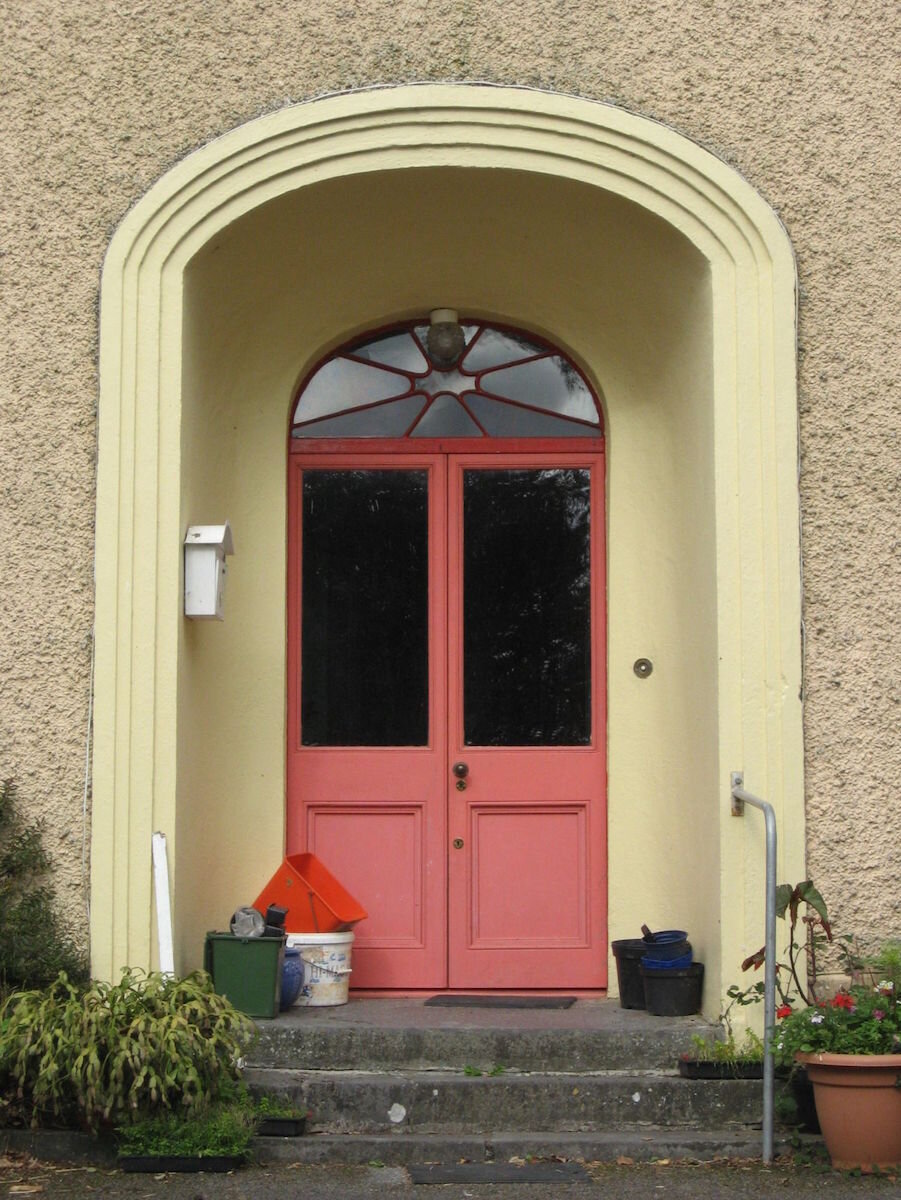
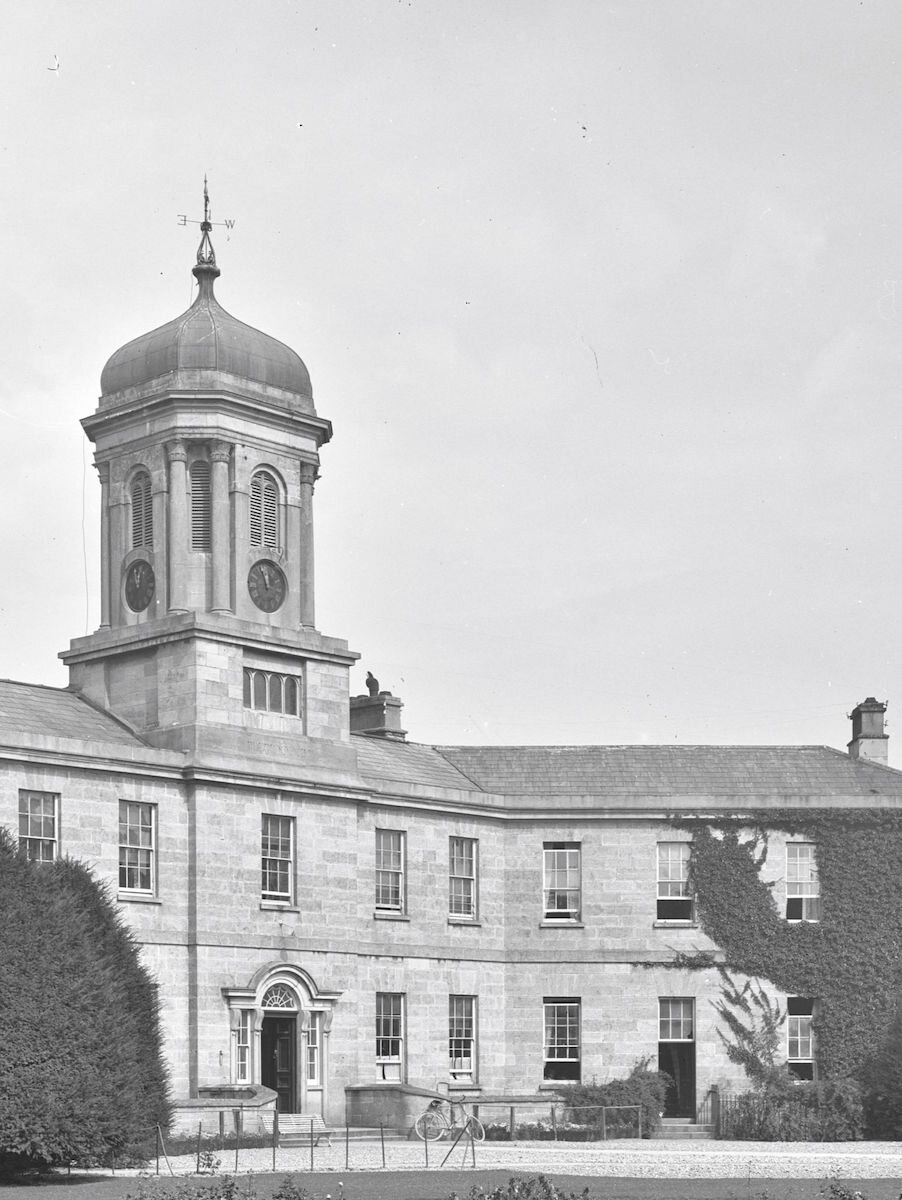
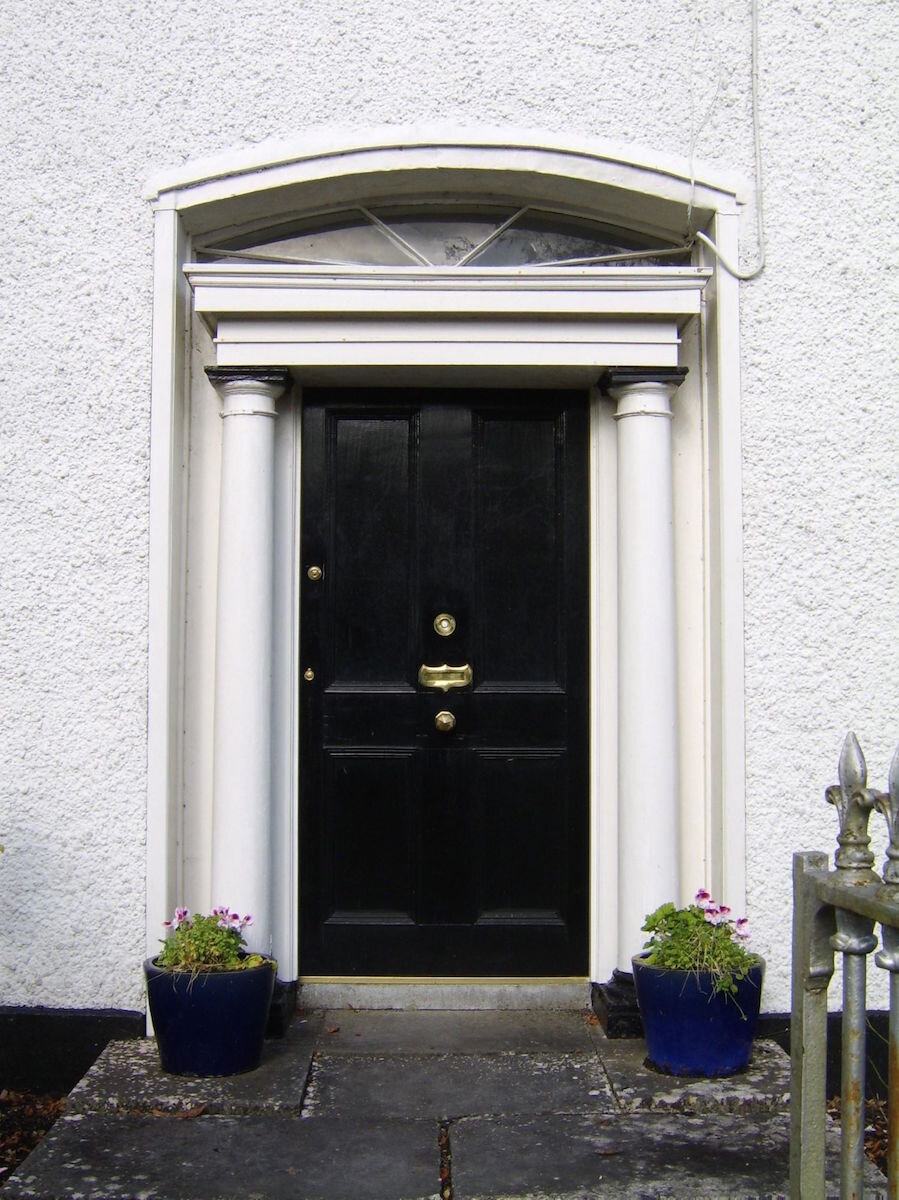
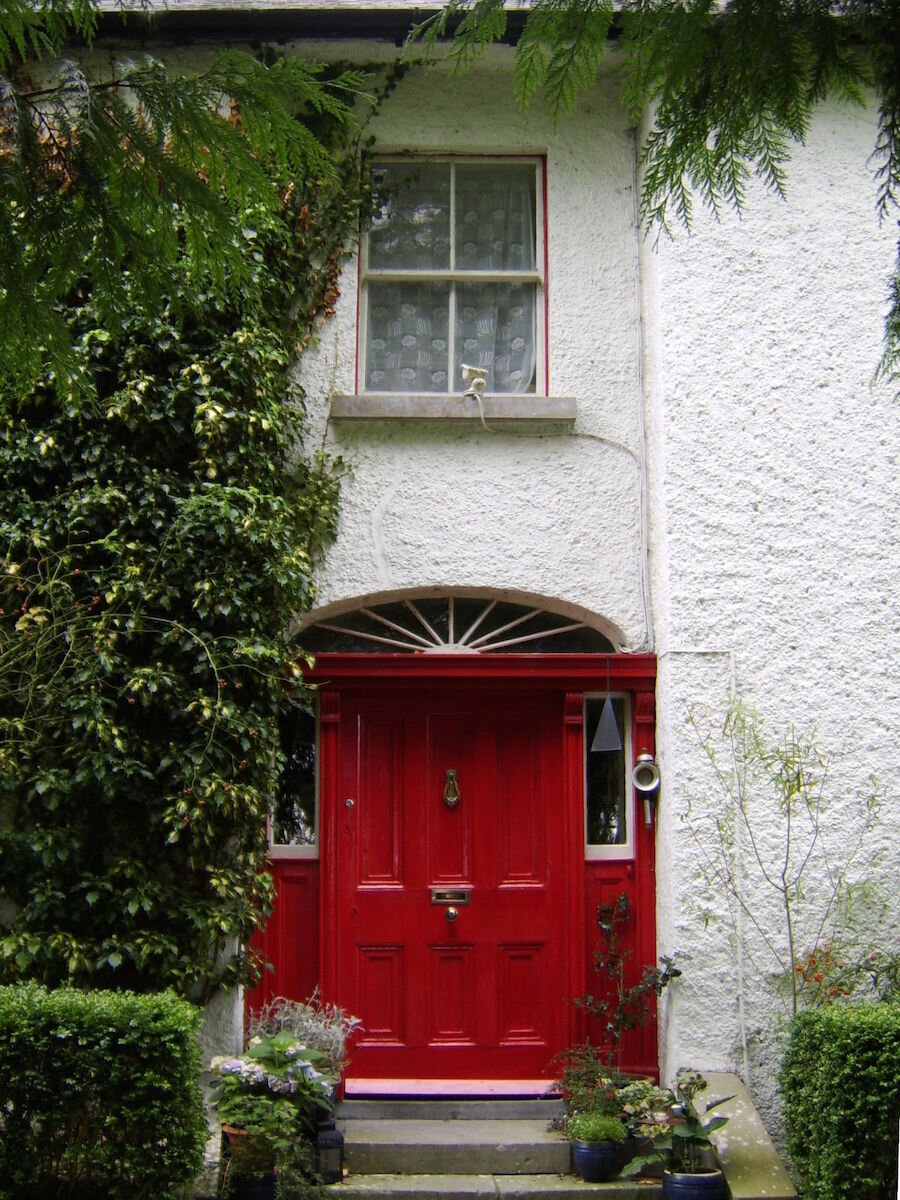
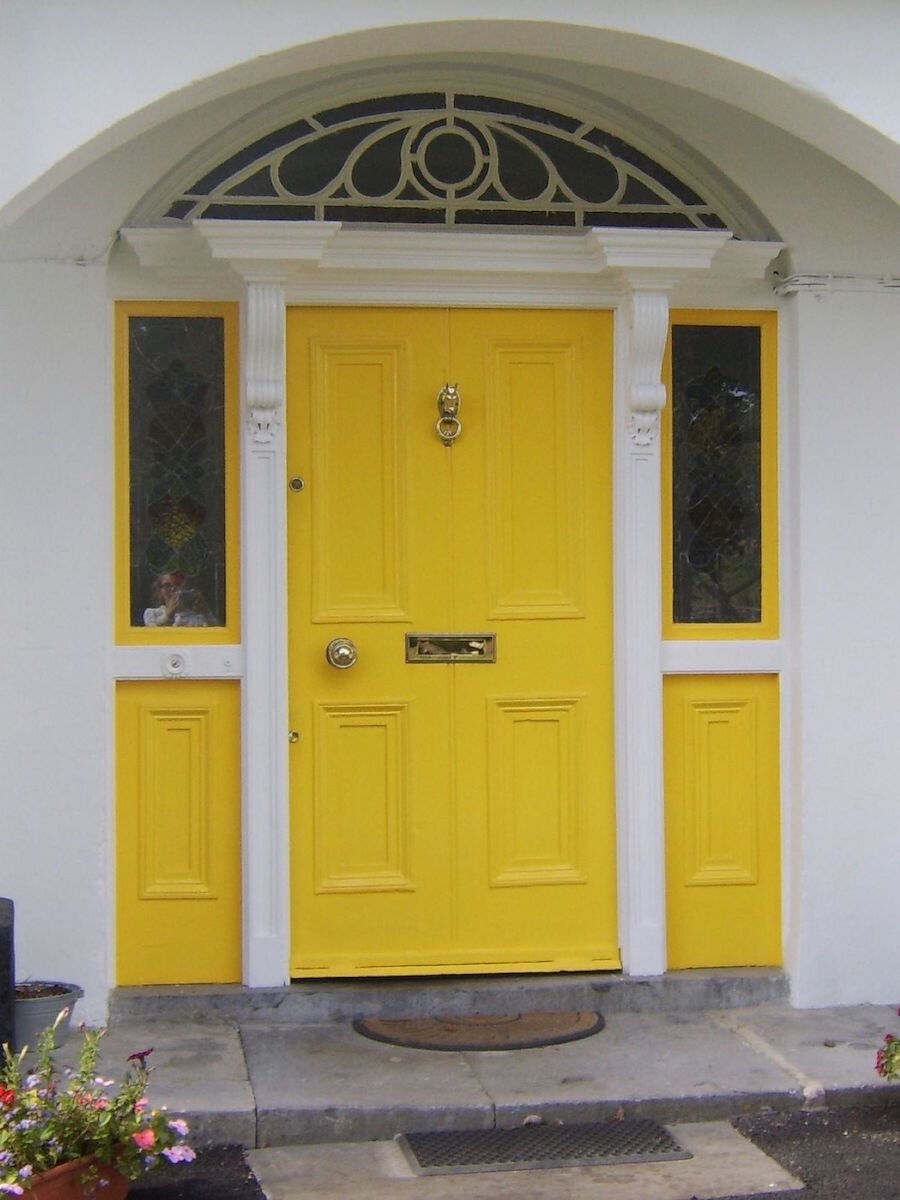
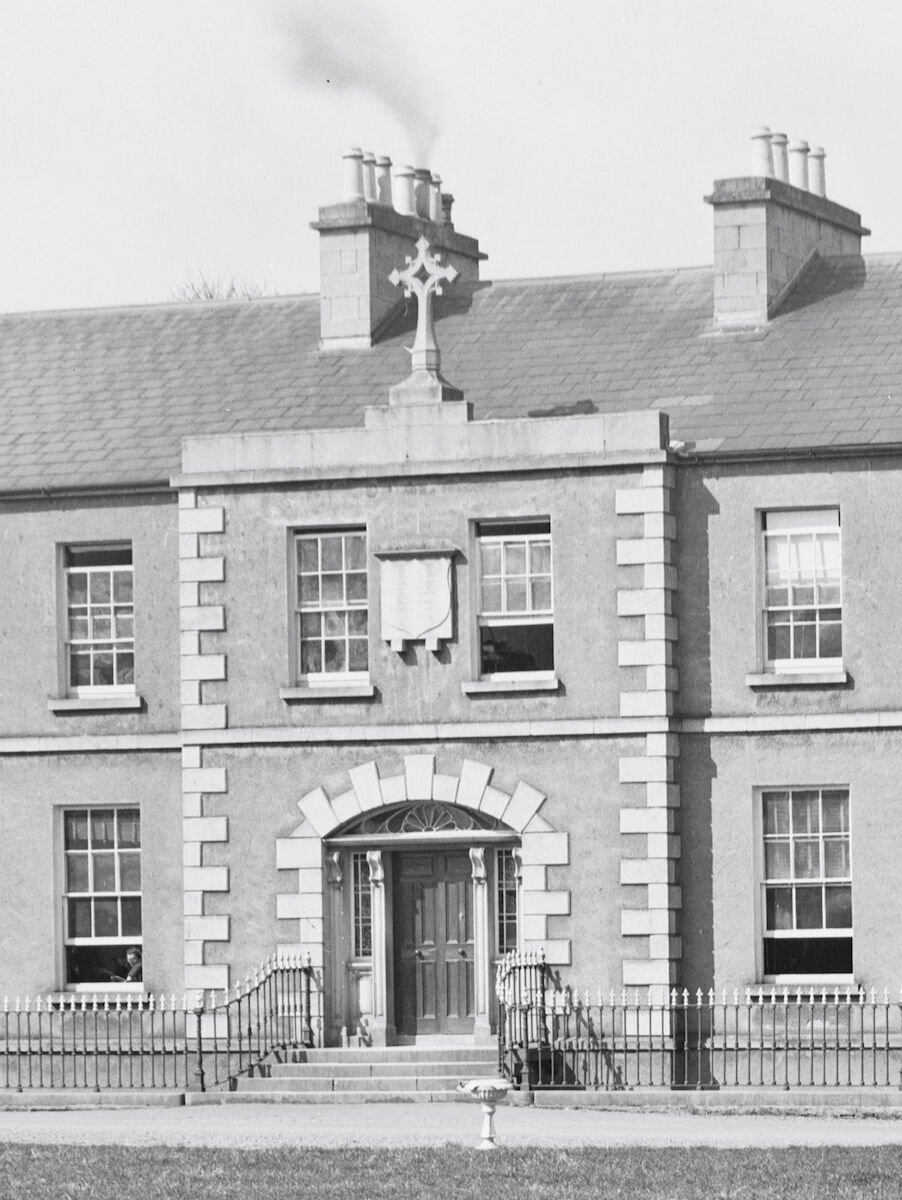
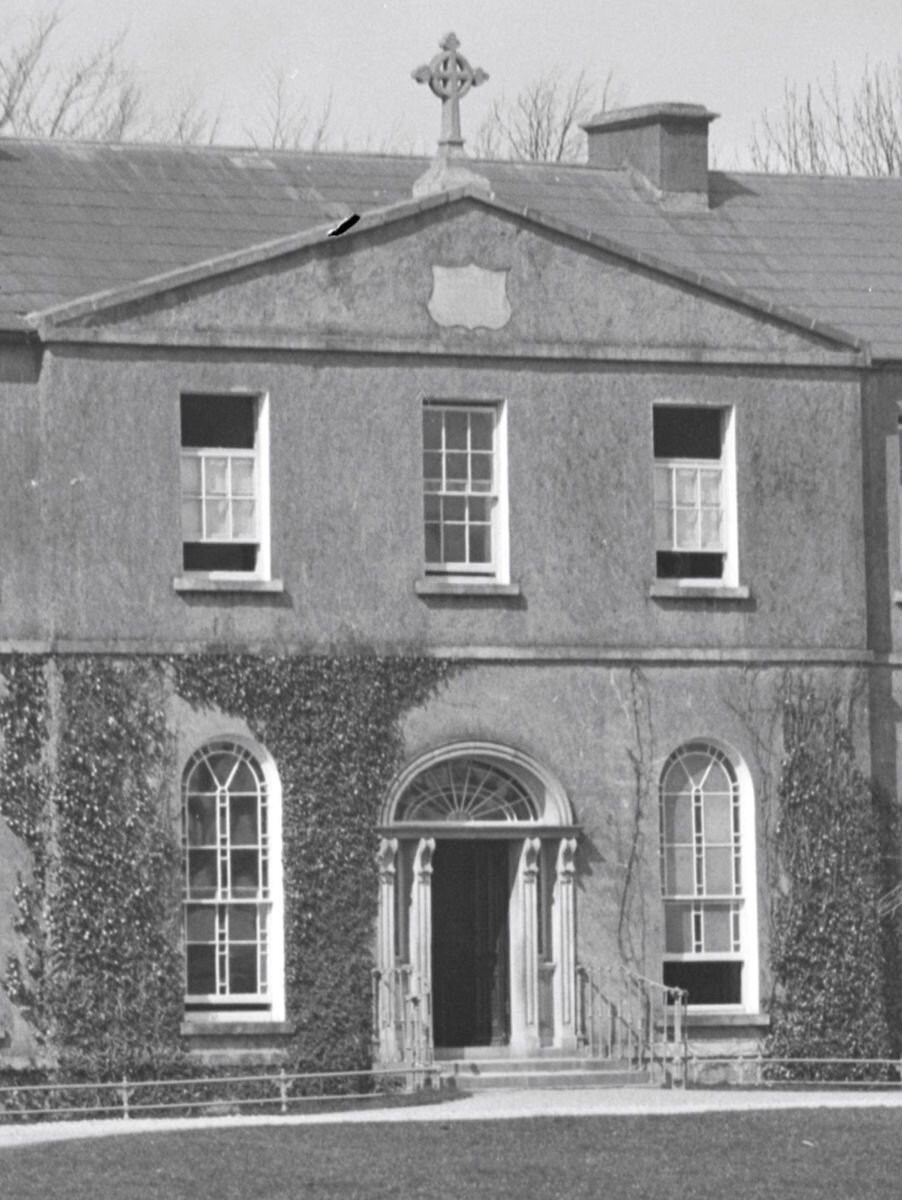
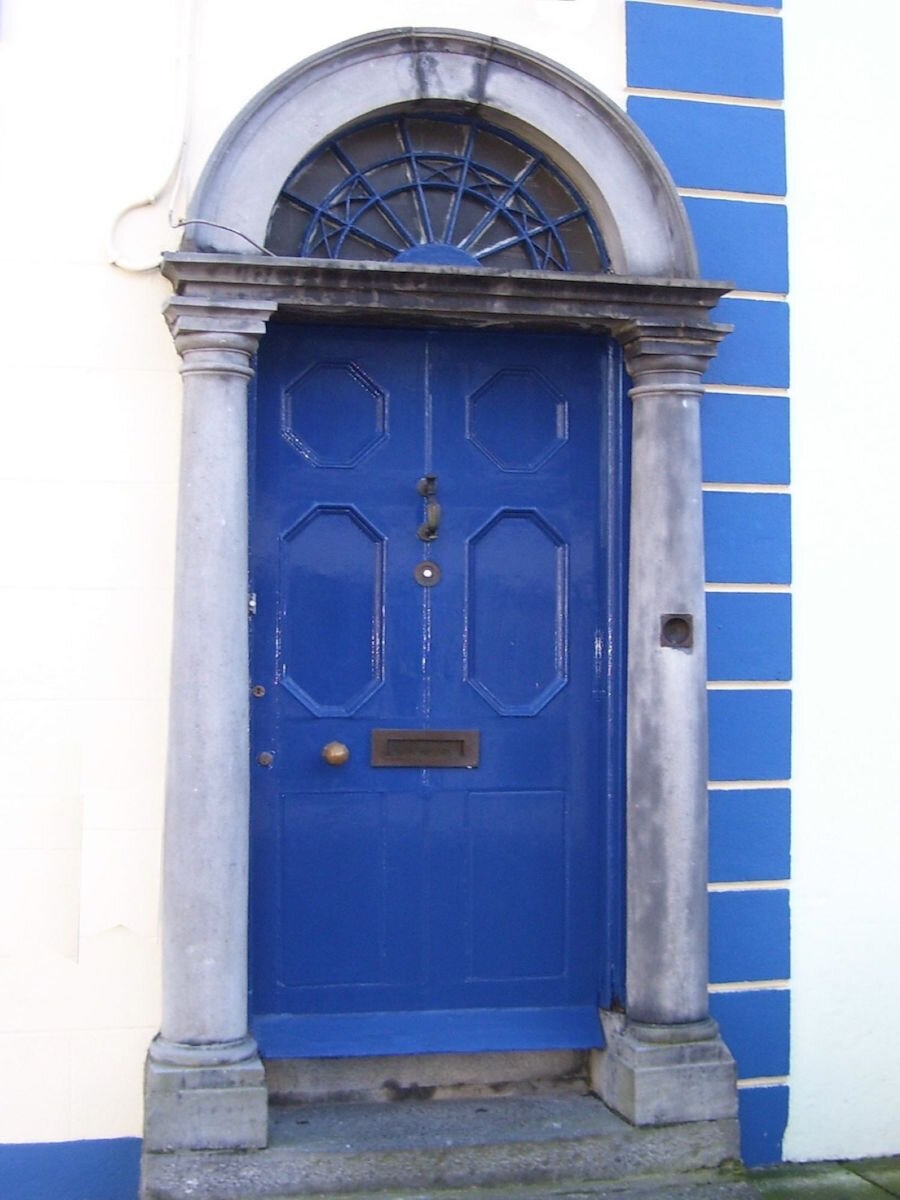
We will start our virtual tour of Galway by taking a look at some large country houses and farmhouses before turning our attention to the city. Then, in a sweep south and east, we will look at very best fanlights in Loughrea, Gort, Portumna, Ballinasloe and, last but not least, Tuam.
There are a few country house fanlights in the west of the county. Ross House, now called Ross Castle, has been restored after falling into ruin. Its original ornate cobweb fanlight was captured in this photograph by Robert French (1841-1917) who was chief photographer for the Lawrence Company. Ardvarna, Oughterard, is an early nineteenth-century house with a busy cobweb fanlight containing twelve spokes radiating from a large solid hub. It also has geometric lights either side of its original door. A very fine ensemble indeed!
Derryvoulin and Mill House, near Woodford in south County Galway, were captured on film for the Lawrence Company over a hundred years ago. Derryvoulin, now called Shannon Hill, has a straightforward cobweb fanlight, while that of the Mill House had spokes radiating from a solid hub.
The design of the fanlight at Hearnesbrook, just west of Killimor, is very unusual. Sheltered under a Doric portico, it is a stylised version of the mediaeval "fleur-de-lis" pattern, featuring a cluster of five bulbous petals surrounded by a very ornate border of tiny quatrefoils.
Ballymore Castle, Laurencetown, a fine small country house of 1815 abutting a sixteenth-century castle, boasts an extraordinary fanlit, clustered colonnette doorcase. In design terms the fanlight appears relatively straightforward as a simple cobweb with lenses in a band lacing the spokes together. The presence of detailed sidelights with a quatrefoil centre and stained glass circlets elevates the design to the unusual. But what lifts it to the realm of extra special is that it is constructed on a curve in the bow of the house. This makes Ballymore Castle one of only very few such fanlights in Ireland.
A completely different but equally elegant design is found at Saint Cleran's (1807), north-west of Loughrea, by Sir Richard Morrison (1767-1849). A rectangular fanlight filled with three ovals forms part of a finely judged ensemble framed by the pillars of a Doric portico.
Liskelly House, south of Aughrim, has a handsome geometric spoked fanlight. Derrynabuie House, Clonbern, has a simpler version of this effective way to embellish a plain spoke pattern.
The ruined Clonbrock, west of Ahascragh, had a lovely fanlight with a simple but unusual set of Gothick pointed arches. It can be seen behind a motoring party in this evocative photograph of a lost age from the Clonbrock Collection. Rockwood, on the border with Roscommon, is no longer standing but is remembered by the aptly named Grand Lodge which is one of the few fanlit gate lodges in the county. It has a dapper elevation with matching switch-track fanlight and Gothic-arched sash windows.
Moylough House near Mountbellew Bridge has an ornate metal cobweb fanlight within a cut stone doorcase. It is understated for not being painted a light colour as was usually done. The nearby Windfield House has a pretty coronet-type cobweb with curved V hub and applied ornaments. Castle ffrench (1779) has a very solemn cut-stone doorcase but all six spokes and the double band of its elliptical fanlight are embellished with applied ornament, giving it a touch of sophistication.
Bermingham House, east of Tuam, dates back to the mid eighteenth century but its singular fanlight is most likely a later addition from the early nineteenth century. It is composed of a base row of three semi-circles, on which balance a central oval supported by two slanted teardrops. It is a most elegant and well-judged design.
Galway City has some interesting fanlight hotspots but very few survive in the city centre. A Lawrence photograph of Eyre Square shows that the premises of W and A Gilbey had a unique fanlight consisting of four upright ovals. Forster Street House on College Road has an immaculately presented Doric doorcase with spokes radiating from a large solid hub; solid hubs seem to be a local preference. Ozanam House, 11-13 Saint Augustine Street, built in 1795 by Walter Joyce (1763-1853) of Merview, has an uncommon variation on a combined cobweb and petal: the border is a series of inverted lenses created by the junction of petal and cobweb curves. Corrib House, Waterside, has a very elegant doorcase with a radiating fanlight over sidelights.
The Nun's Island area west of the Corrib retains a handful of fanlights and Saint Clare's Convent at the north of the island has a simple hub and spoke design. Simple radial lights predominate in Nun's Island Street but the Doric doorcase of 25 Nun's Island Street features a hub and spoke fanlight with a plain margin pierced by every second spoke, an unusual variation, while a house on the opposite side of the street has a rectangular fanlight with a quarry pattern. The only fanlight on Mill Street is a petal type framed by a handsome doorcase at no.15.
Before leaving Galway, we can take a quick look at the houses of Montpelier Terrace, in the south-west of the city, which boast a very unusual, simplified Claddagh Ring-type clasp design. This singular design has just a few distant relatives in Pembroke Street in Carlow Town.
Most of the fanlights in Loughrea are on the periphery of the town. The former town hall in Barrack Street had three rectangular fanlights with unusually large diamond or quarry panes but, unfortunately, the building has recently been boarded up. Rock House, Bride Street, has a fine cobweb fanlight over an original early nineteenth-century door with octagonal panels. There are two delicate cobweb curves between each spoke in the arched border. Waterview, a late eighteenth-century villa in Cross Street, has a simple radial fanlight in a recessed stone doorcase and an unusual clerestorey light almost concealed from view behind the arch overhead.
Gort hosts a smattering of fanlights. A bold Gibbsian doorcase on Market Square has the most curious design and overlays a pointed arch and a curved V resulting in a curvilinear version of the Masonic square and compass symbol. Most of the handblown glass survives. A mid nineteenth-century house in Church Street has a fine spoked fanlight which oversails the door jambs; the house stands beside, and was once the deanery of Saint Colman's Catholic Church. A number of radial fanlights survive on the east side of Bridge Street. A house on the opposite side of the street, near Gort Bridge, is set apart by its unusual corbelled doorcase and decorative margined rectangular light.
Portumna, although small, has quite a few interesting fanlights. The old Keane shop in Saint Brendan's Street has a simple three spoke fanlight within a rectangular opening over the house door. The fanlight arch is edged by carved timber sunbursts. Another former shop on Clonfert Avenue has a vernacular margin light over a battened door while its near neighbour has a generously scaled petal fanlight where the hub is formed of cobweb curves; another version of this fanlight is found back in Saint Brendan's Street. Returning to the town centre and a late eighteenth-century house on the corner of Dominic Street and Shannon Road has an elaborate cobweb fanlight over a Doric doorcase. Thankfully it has received some TLC since our photograph was taken ten years ago. This metal fanlight has a double hub with applied floral ornaments, and applied cobweb curves, each offset between the spokes and joined to the border by circlets. Palmerstown House, on the eastern outskirts of the town, boasts a unique starburst design, the spokes spreading from a central, curved eight-sided hub. The doorway sits in a recessed entrance reminiscent of some designs by Francis Johnston (1760-1829).
Ballinasloe has some simple petal fanlights in Dunlo Street including a matching pair at the Garda Síochána Station and simpler version next door. Saint Brigid's Hospital (1831-3 was designed by William Murray (1789-1849) as the Connaught District Lunatic Asylum. It has a fine doorcase with a cobweb fanlight and plain sash sidelights, beneath a curving hood moulding, photographed by Eason early in the last century. A pair of houses on Mountpleasant Avenue feature low, camber-arched, simple hub and spoke fanlights. The neighbouring pair, of similar date, have plain glass – is this original or an alteration? A former school house at the head of Sarsfield Road, designed by William Maxwell and built in 1863, has six spokes radiating from a solid hub: the fanlight sits atop the doorcase rather than being part of it. Beechlawn House, a mid nineteenth-century villa on the southern fringe of the town, boasts one of the very few teardrop designs found in County Galway. It has two tears on either side of the central double circle, all enclosed by a margin, the whole placed over a very well maintained bracketed doorcase.
Mid nineteenth-century educational and religious buildings have given us some of the best fanlights in Tuam. The Mercy and Presentation convents and Saint Jarlath's College have similar tripartite doorcases but with fanlights differing in detail. The original fanlight of the Presentation Convent was a very unusual design with a central petal having double tears on either side. This pattern is seldom found outside County Wexford. The Mercy Convent, originally known as Cornfield House, has a spoked fanlight with double middle band and lovely sidelights filled with ovals. Our illustrations of both convents come from the Eason Collection. The doorcase of Saint Jarlath's College has been adapted as a window but its delicate petal fanlight, with a hub formed of a series of curves, survives. The fine cut-stone Doric doorcase of the former bishop's house in Bishop Street has also been adapted leaving its very ornate cobweb fanlight with solid middle band stranded over a uPVC window. Two fanlights on Dublin Road deserve a mention. The first, a house facing the Bank of Ireland at the west end of the street, has a solid hub fanlight with six spokes connected by an unusually ornate middle band, each segment of which is criss-crossed with glazing bars. Meanwhile, Eastland House, beside the Mercy Convent, has a simple hub and spoke fanlight oversailing a Doric doorcase.
There are many more fanlights in County Galway, some simple, others ornamental, which we have not been able to include on this virtual tour but you can look up your favourite, or discover a new favourite, on the NIAH website: https://www.buildingsofireland.ie/buildings-search/
Fanlights of Mayo
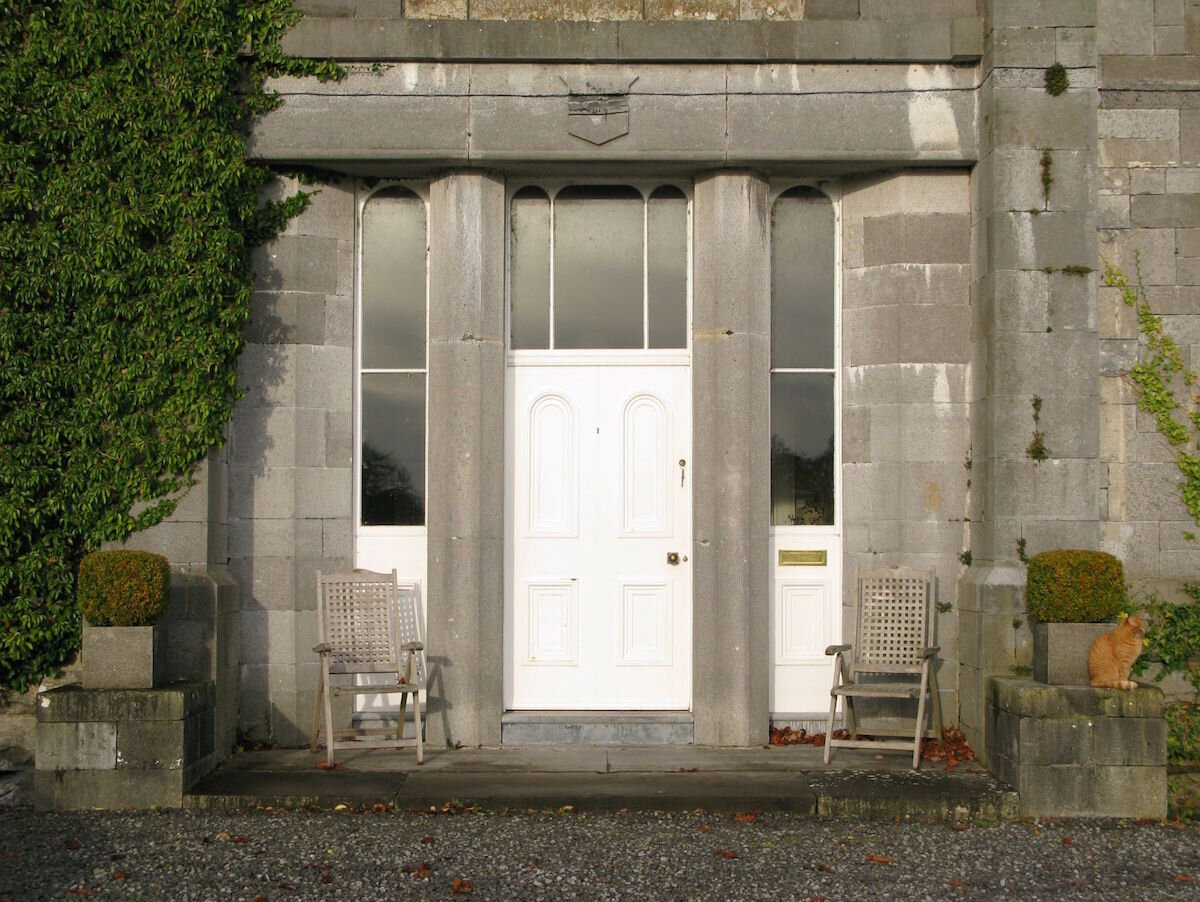
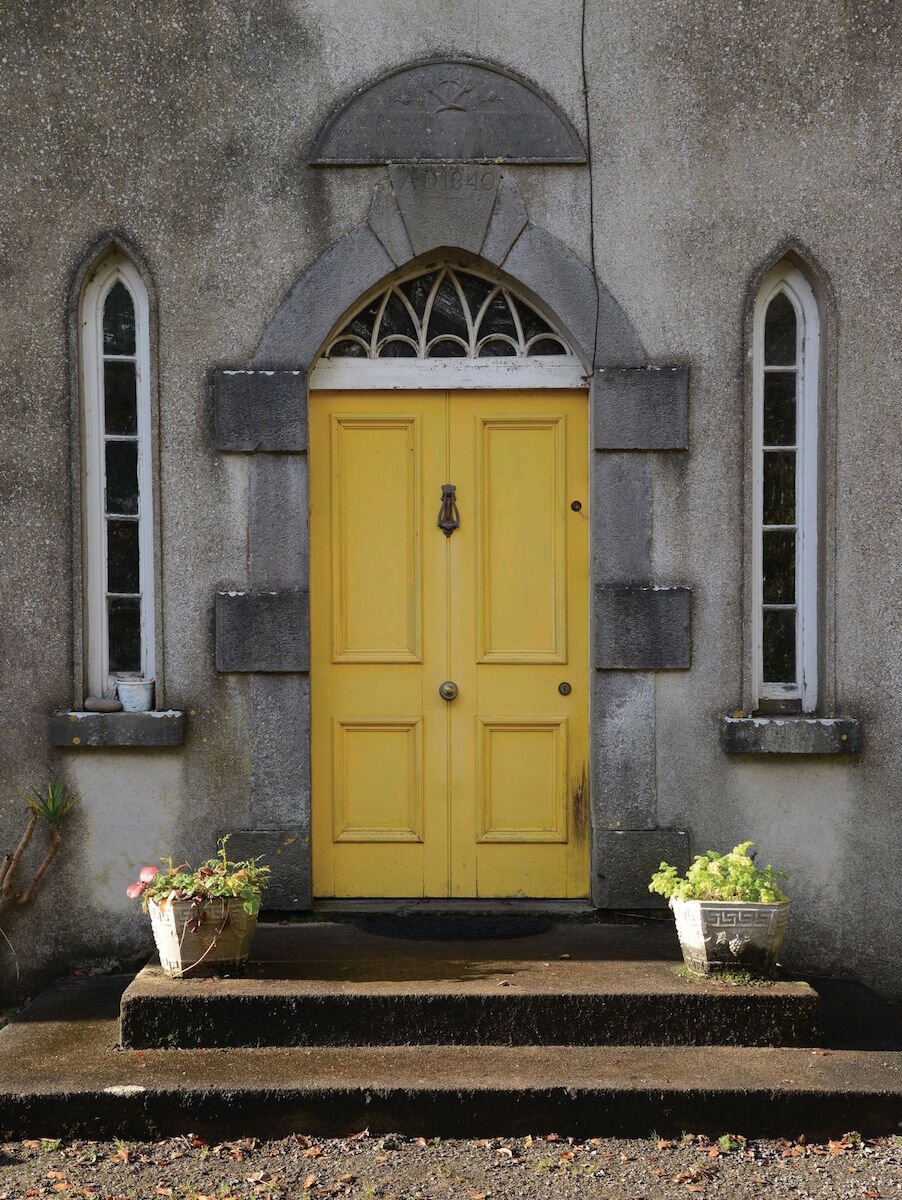
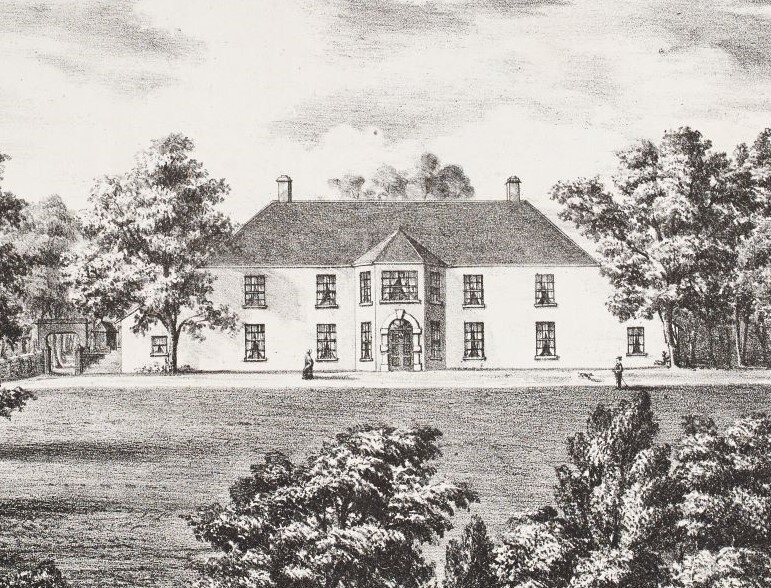
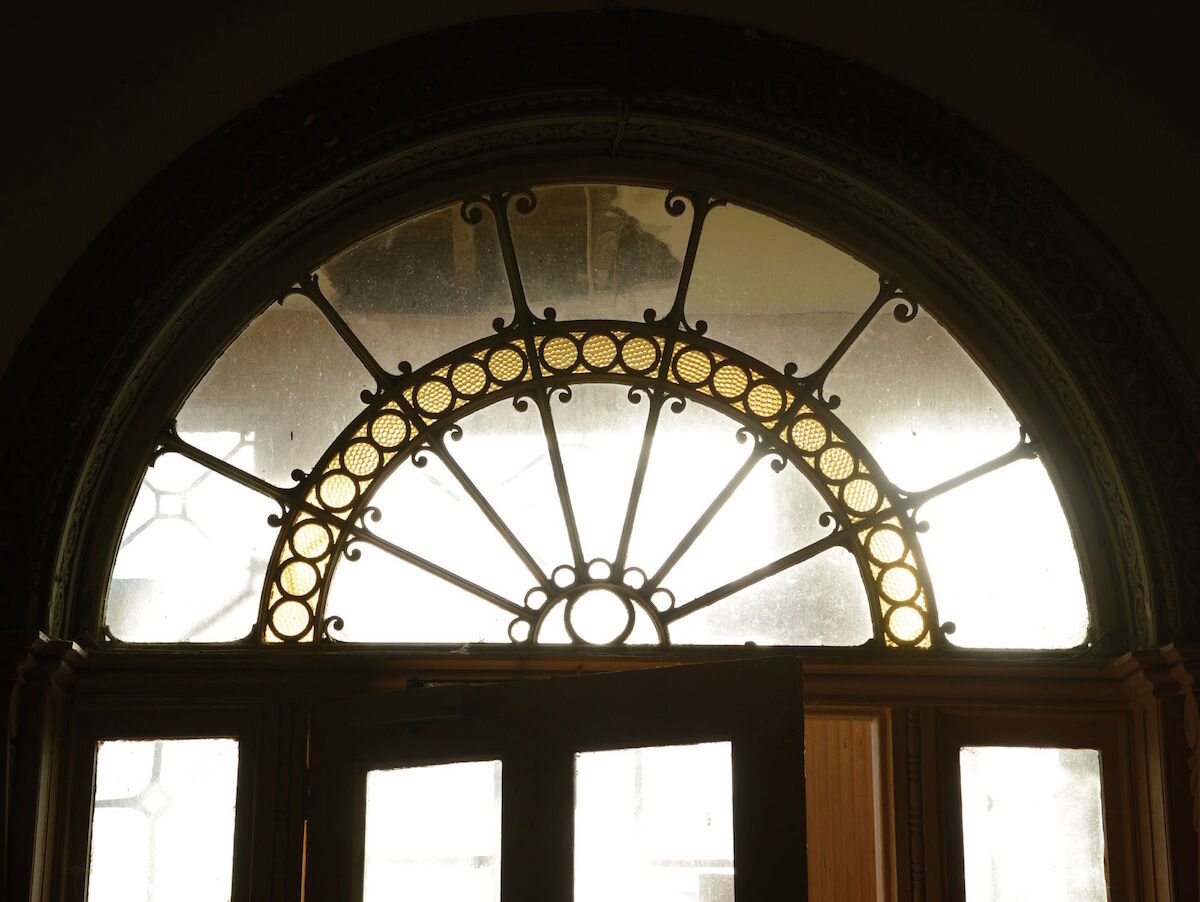
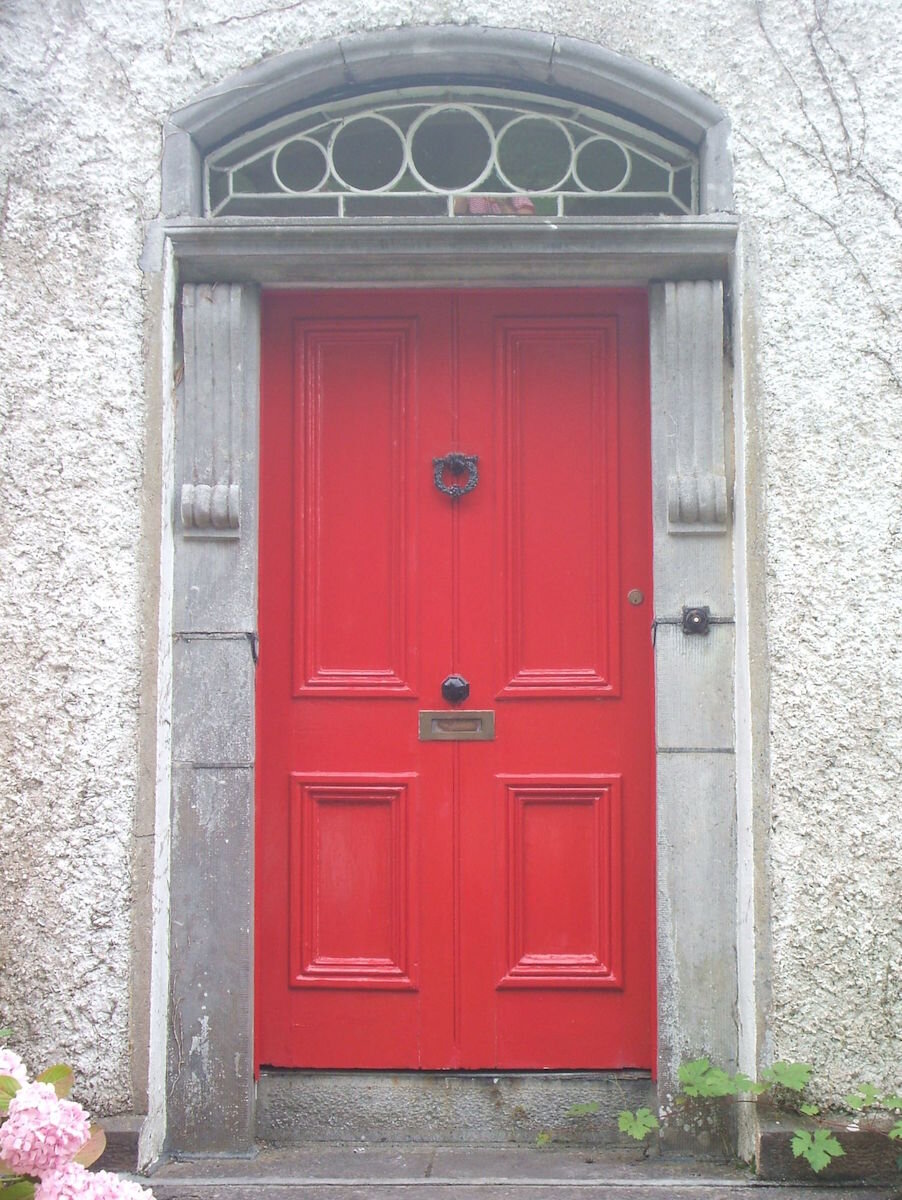
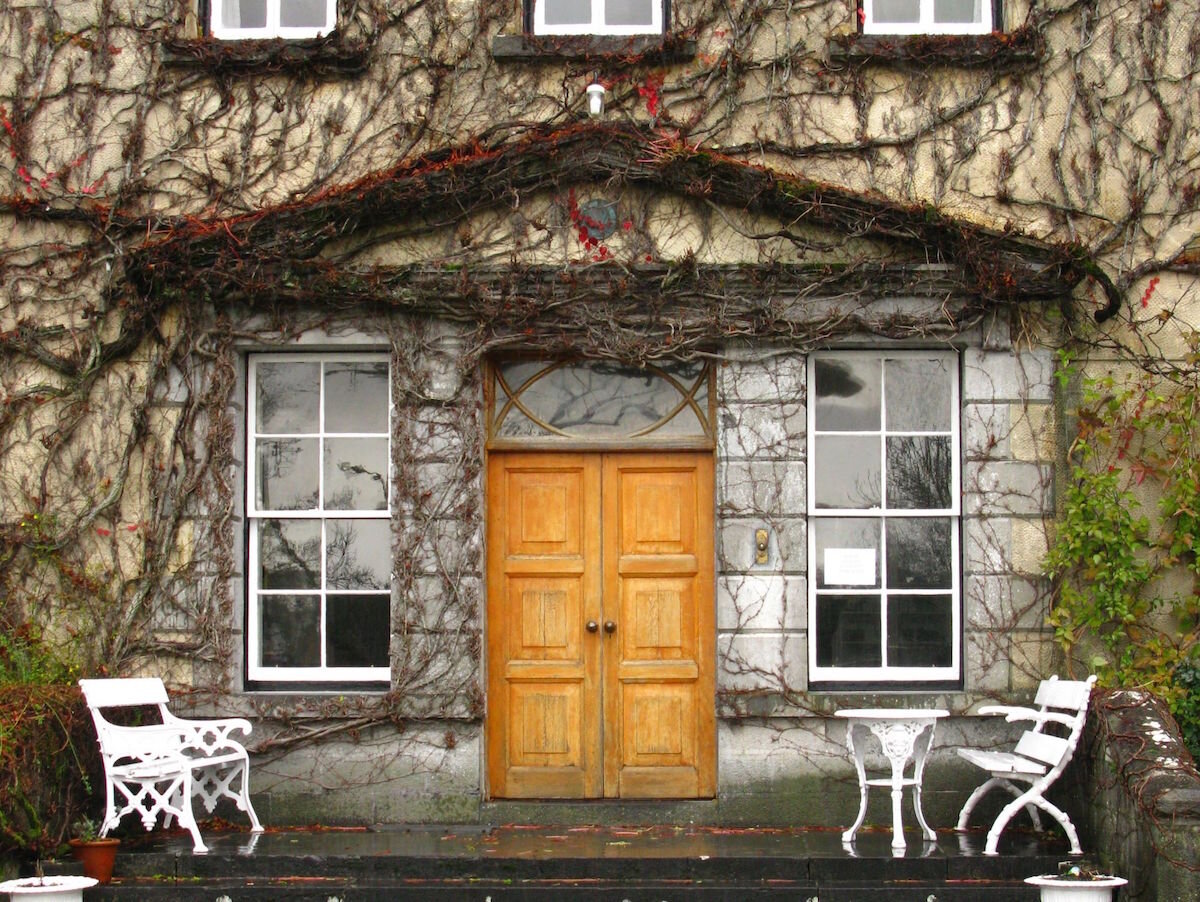
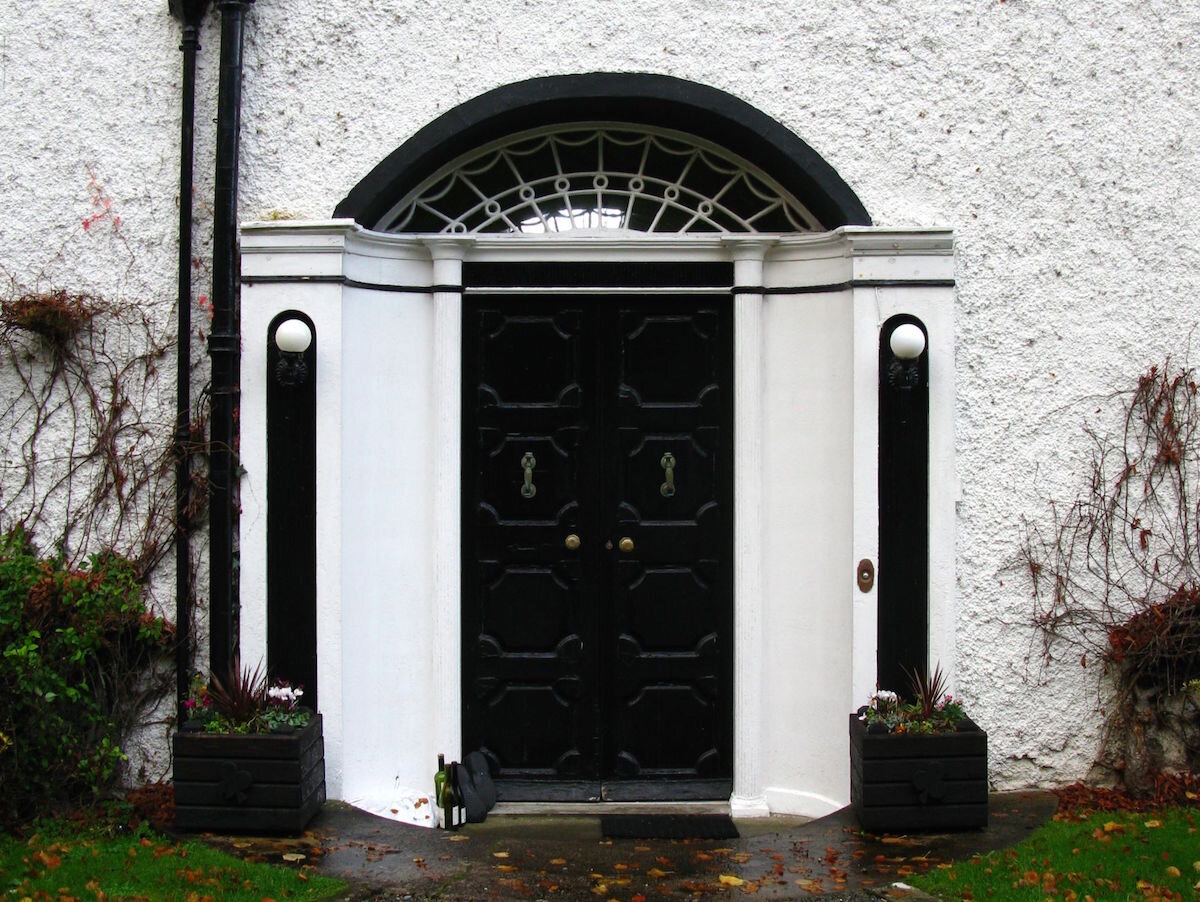
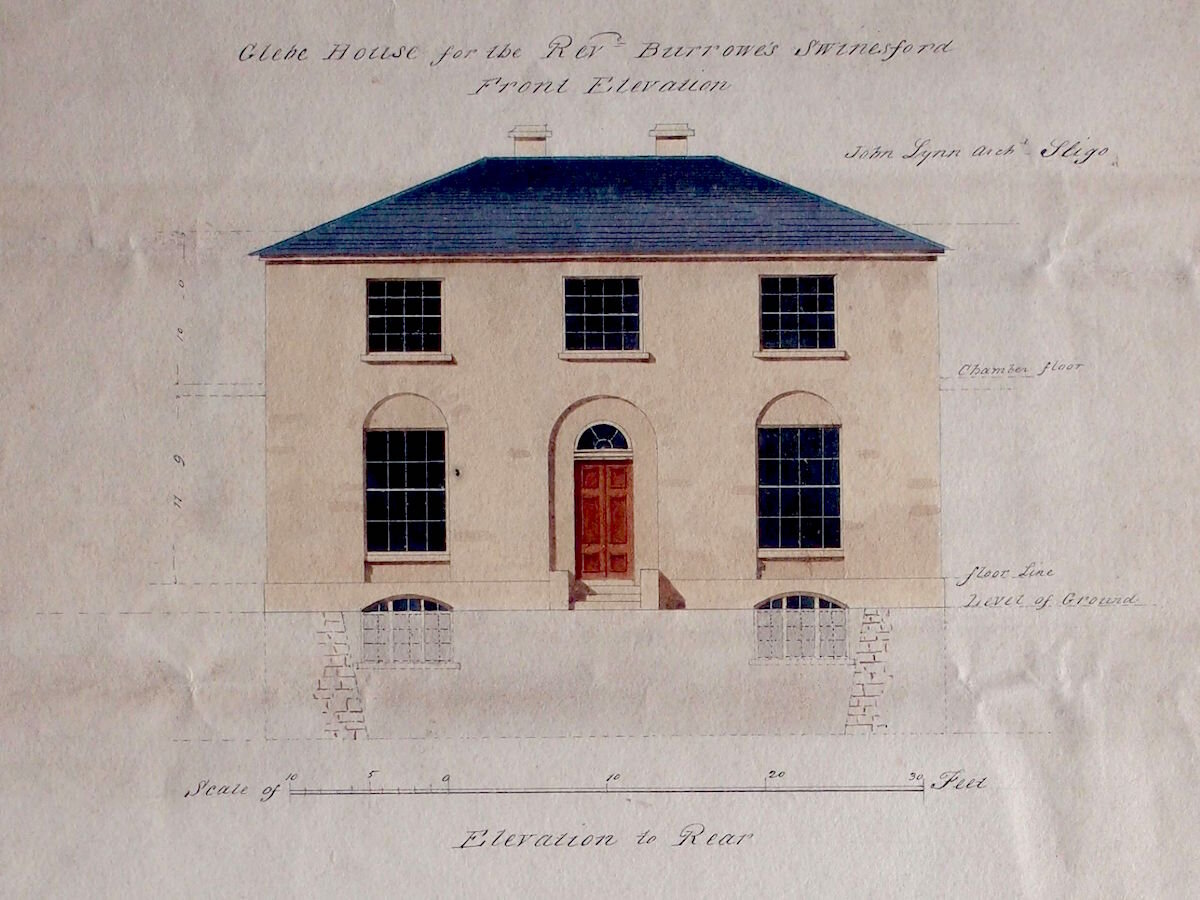
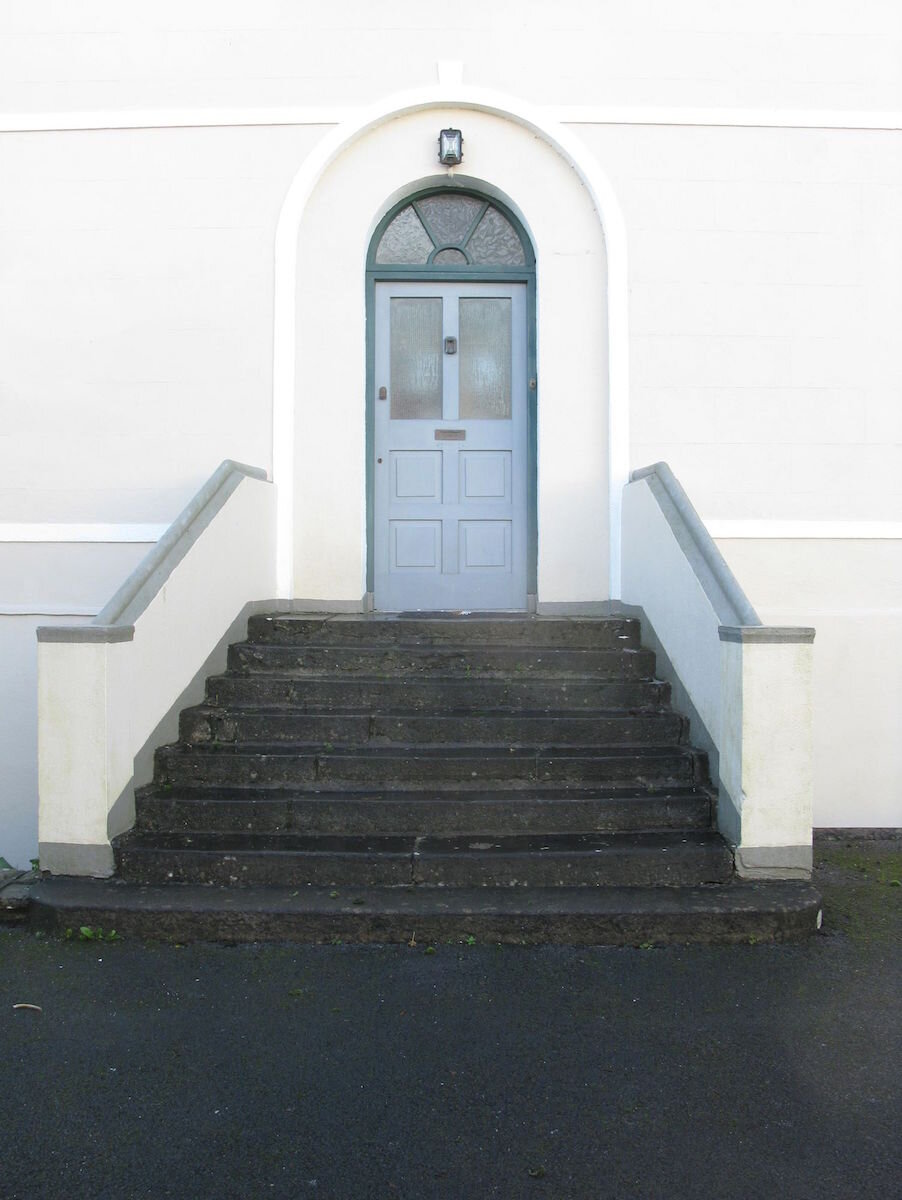
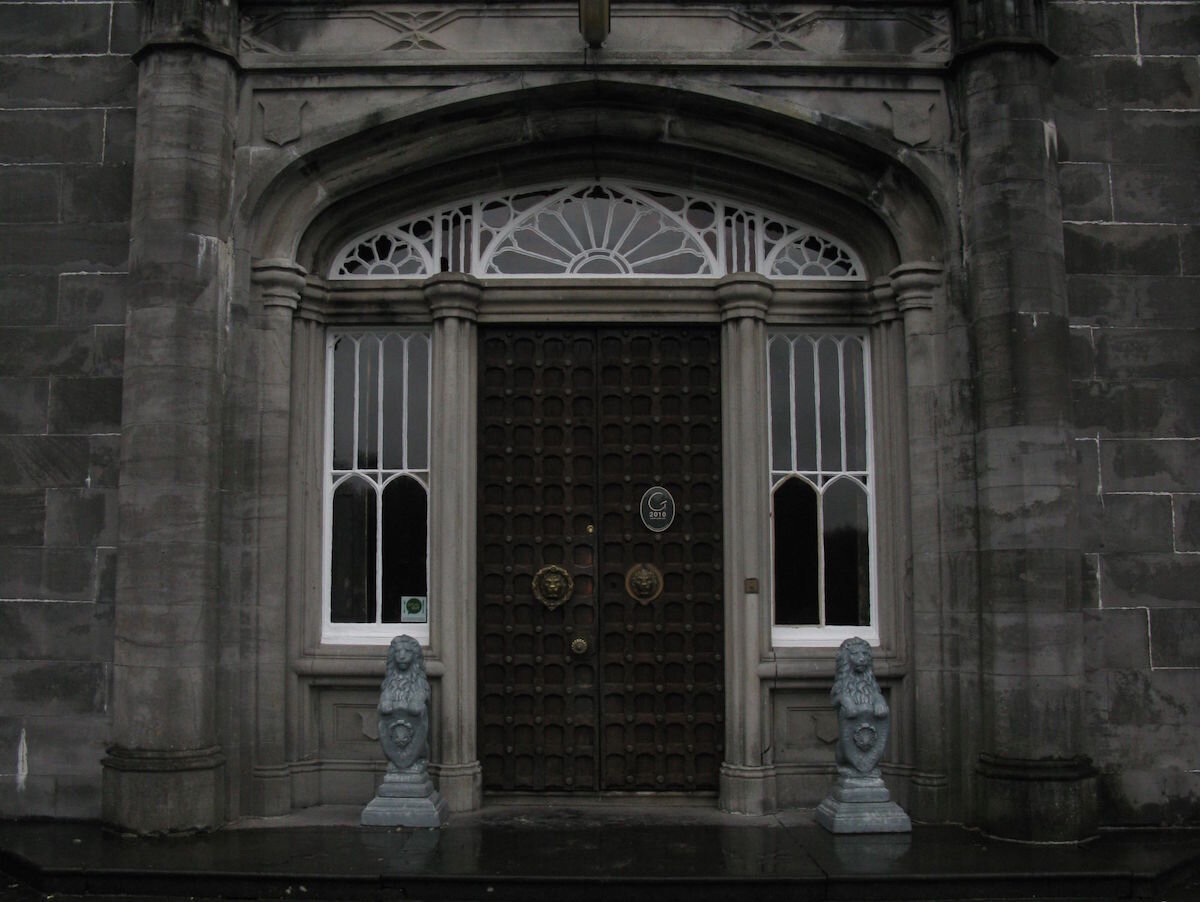
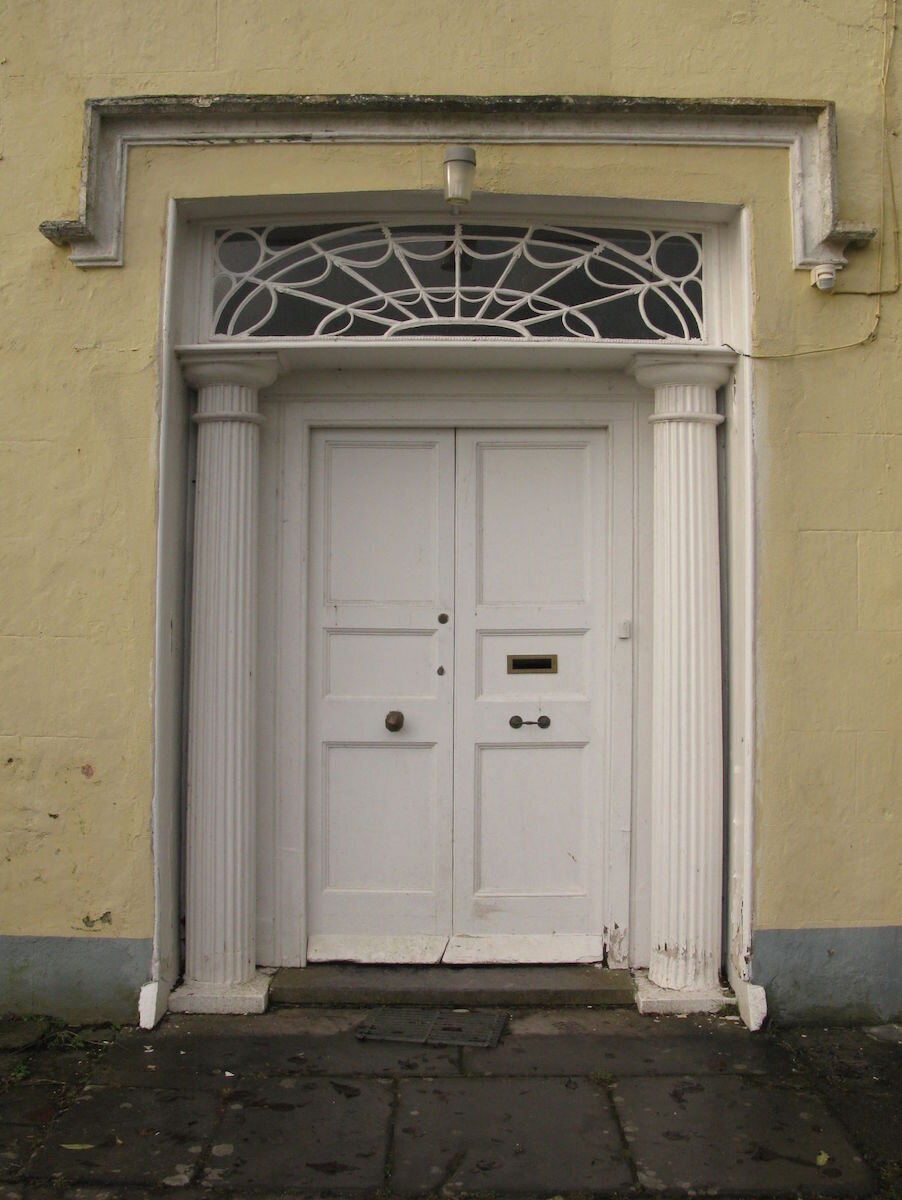
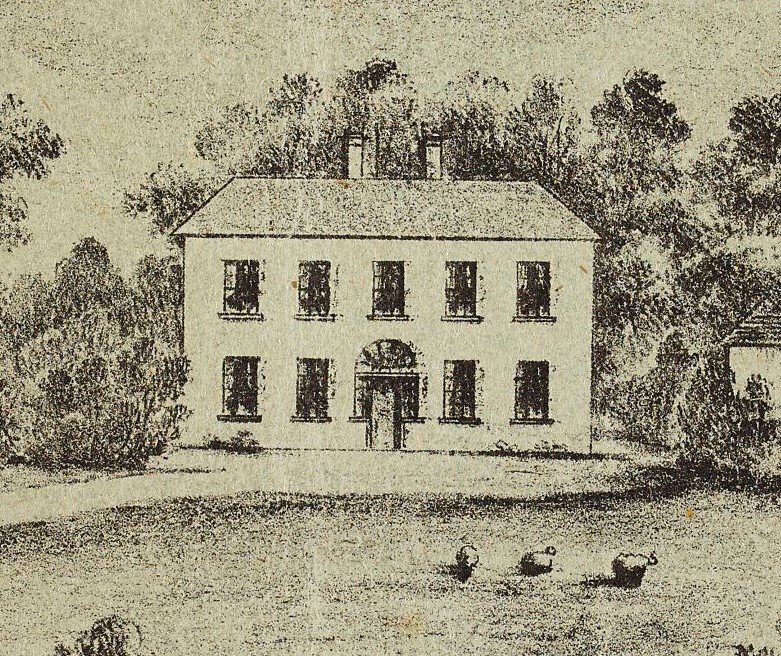
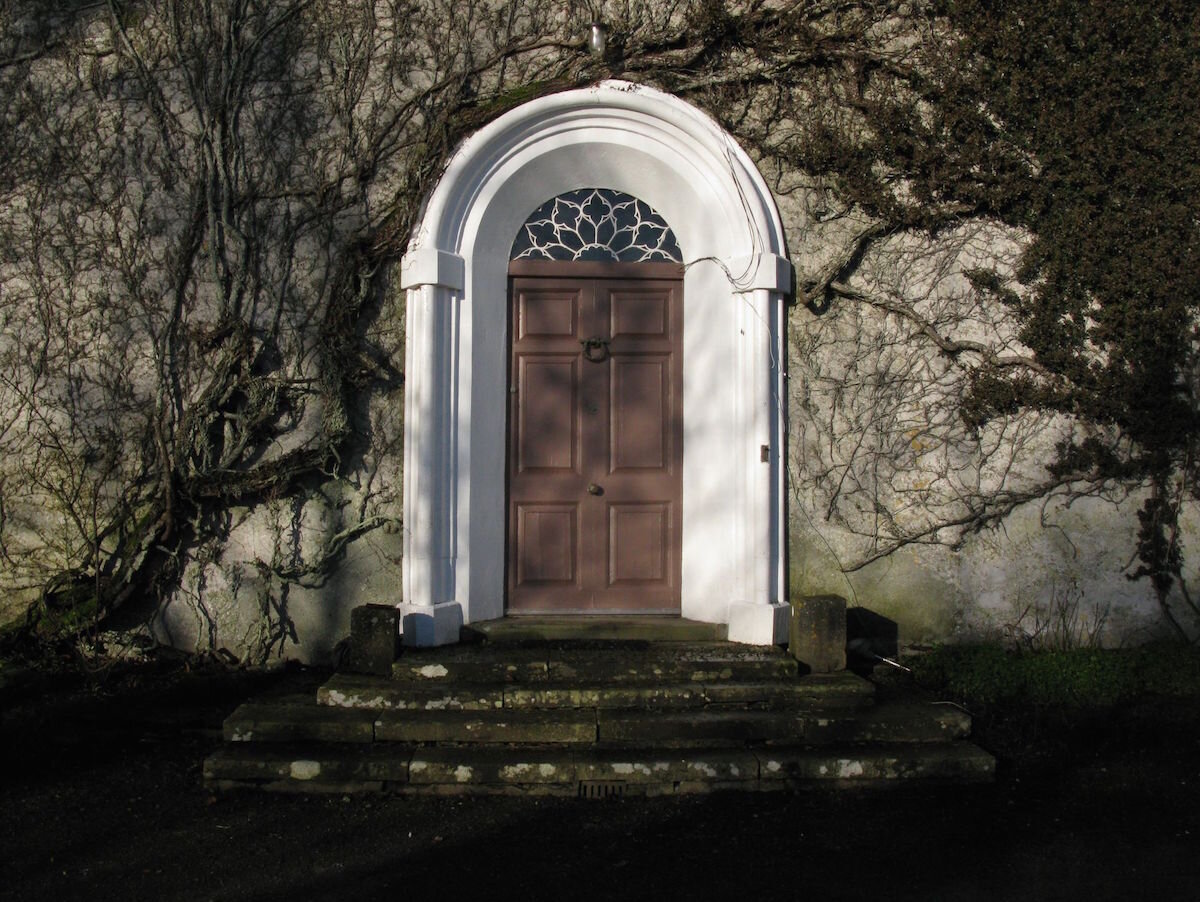
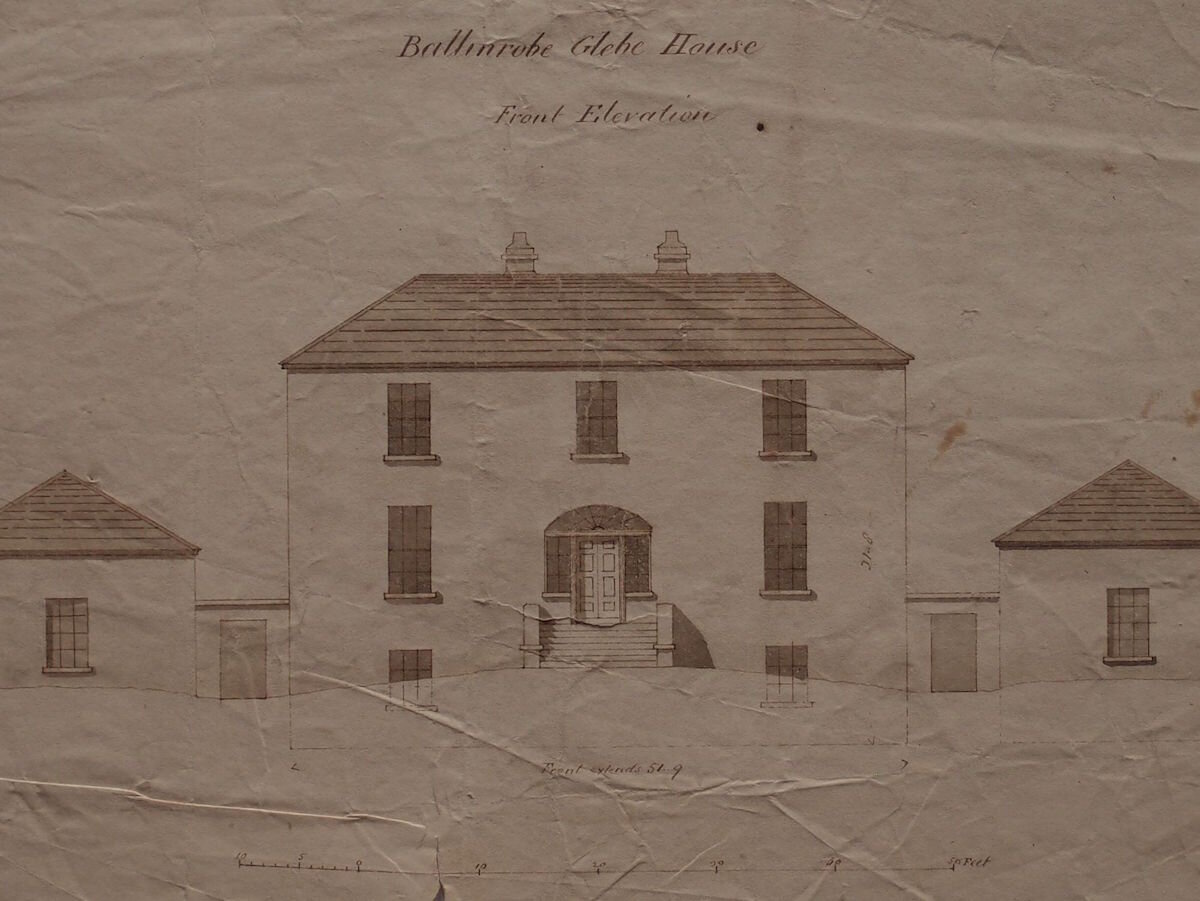

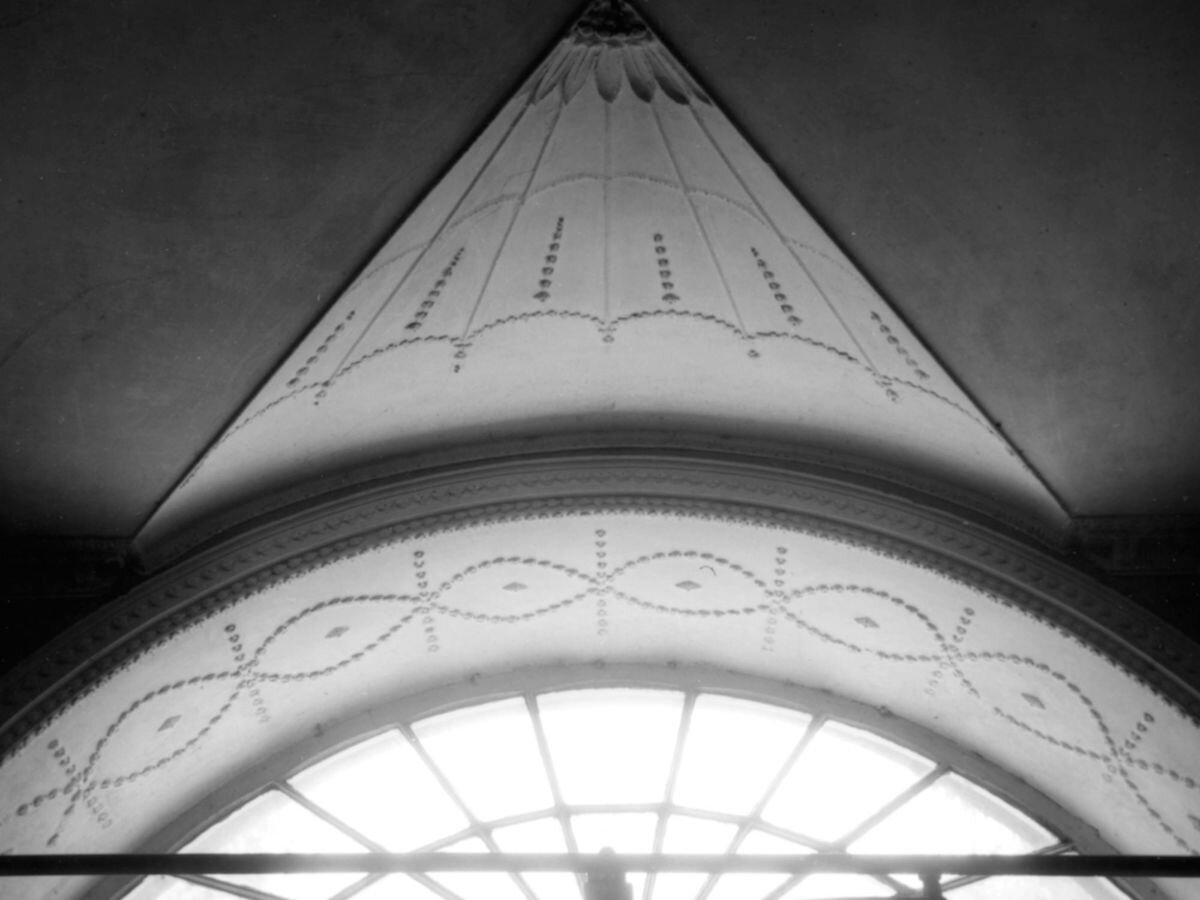
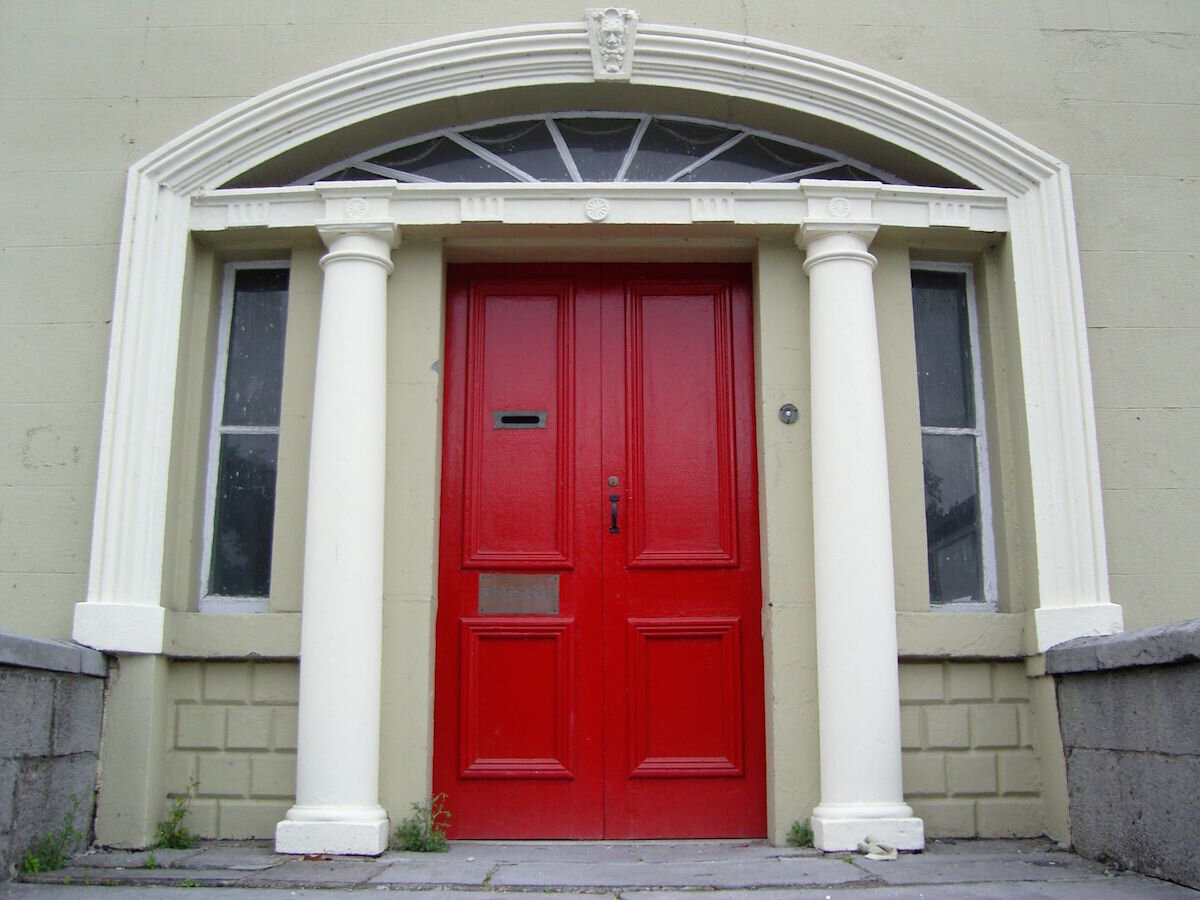
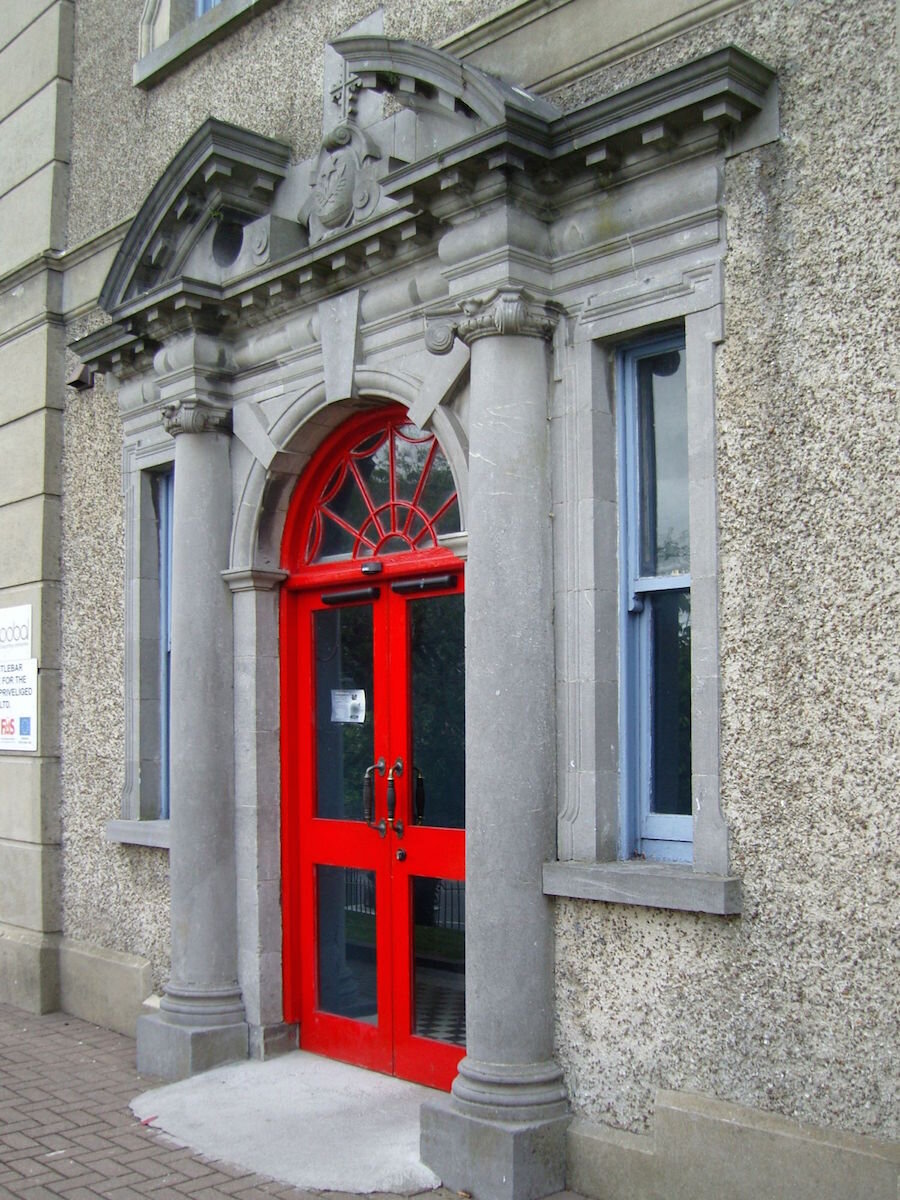
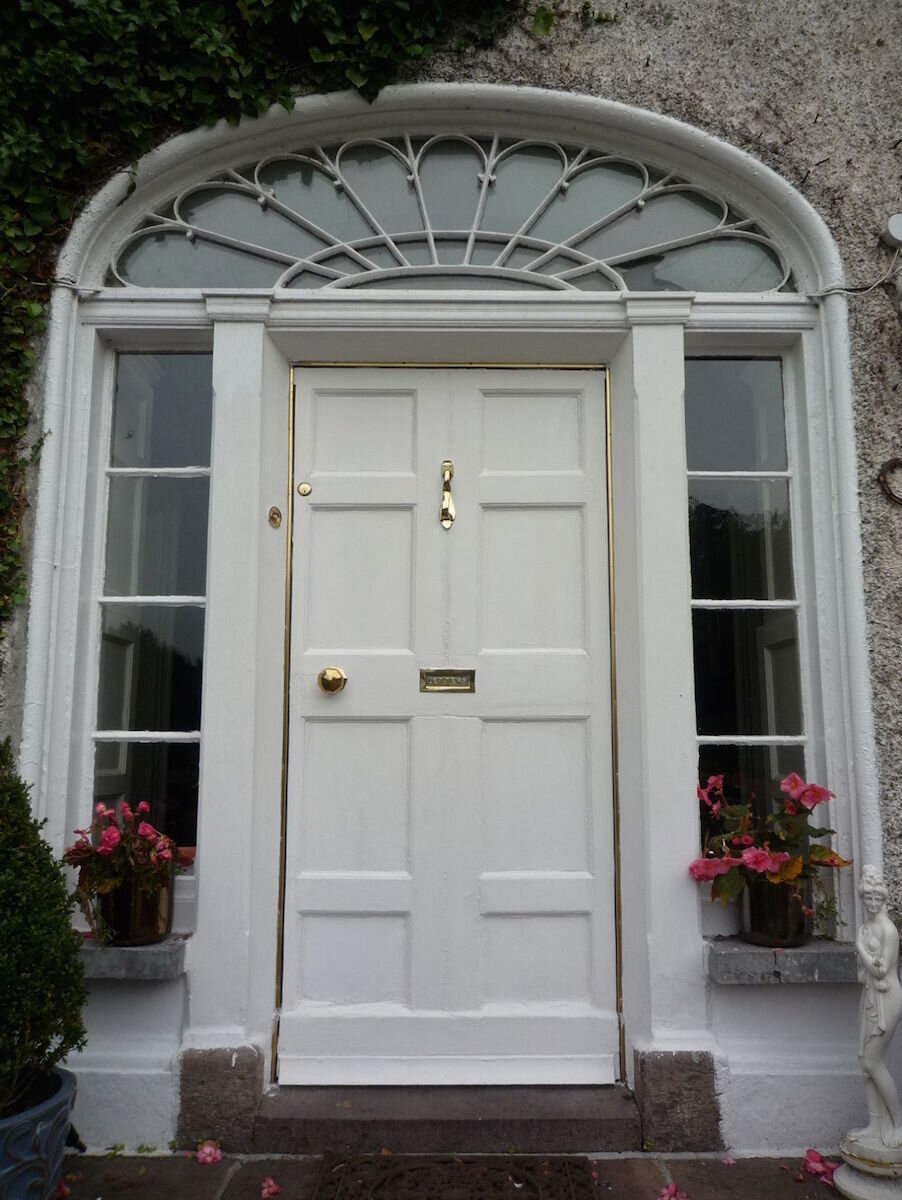
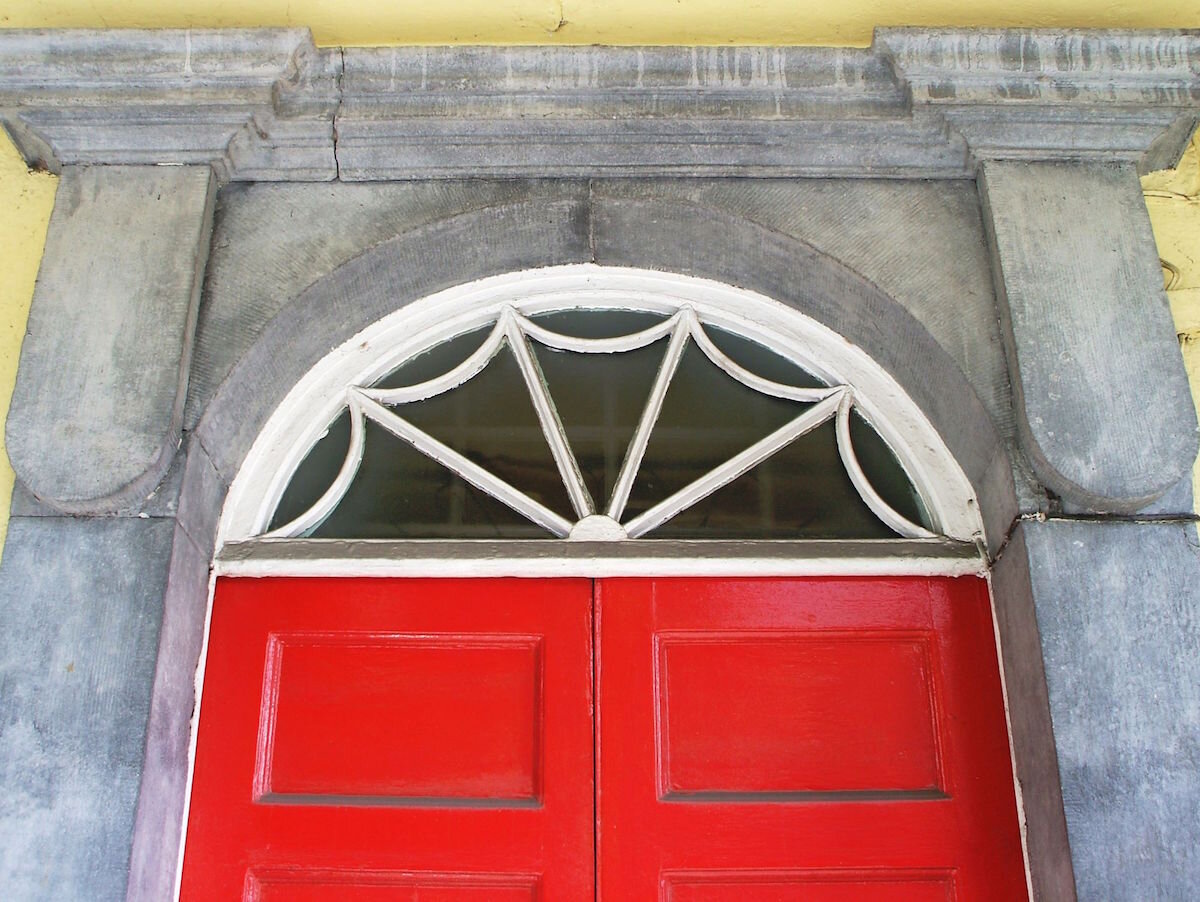
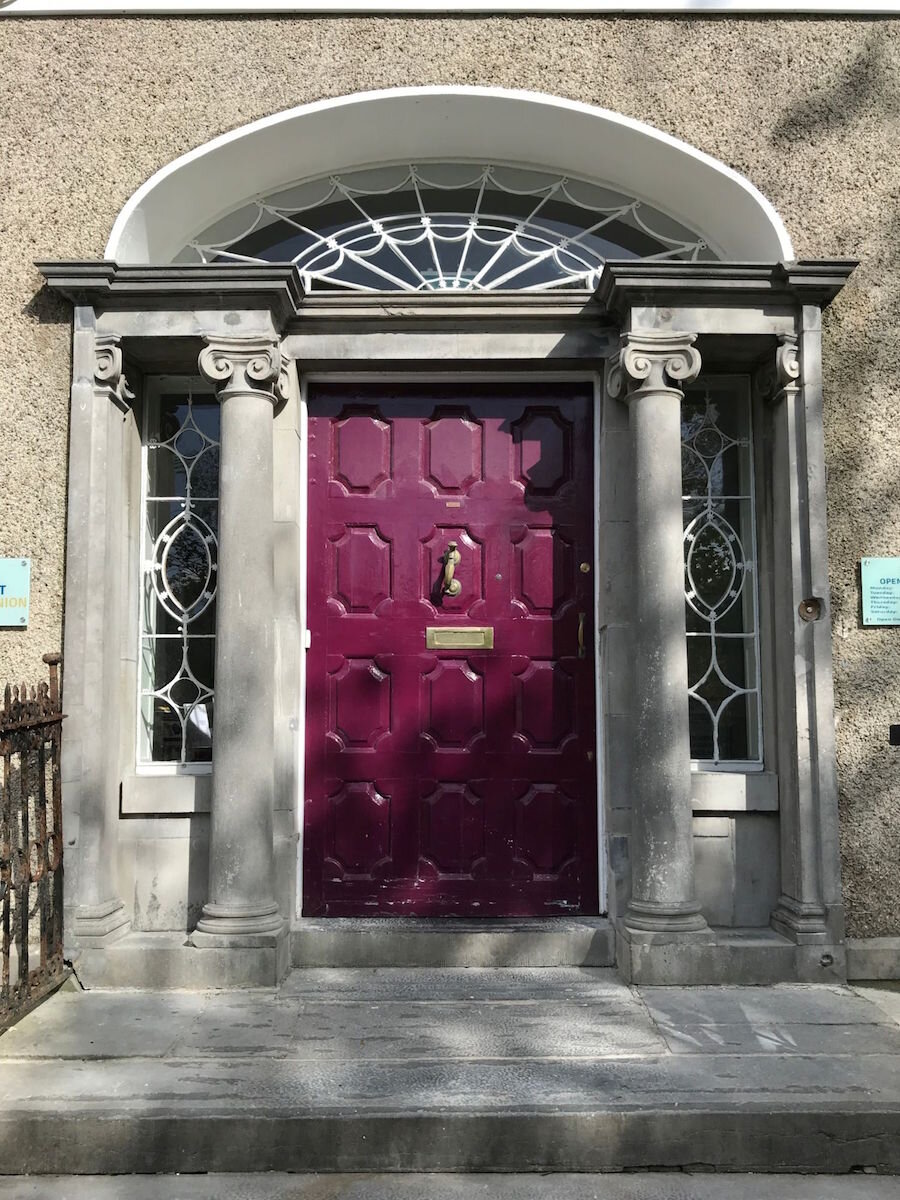
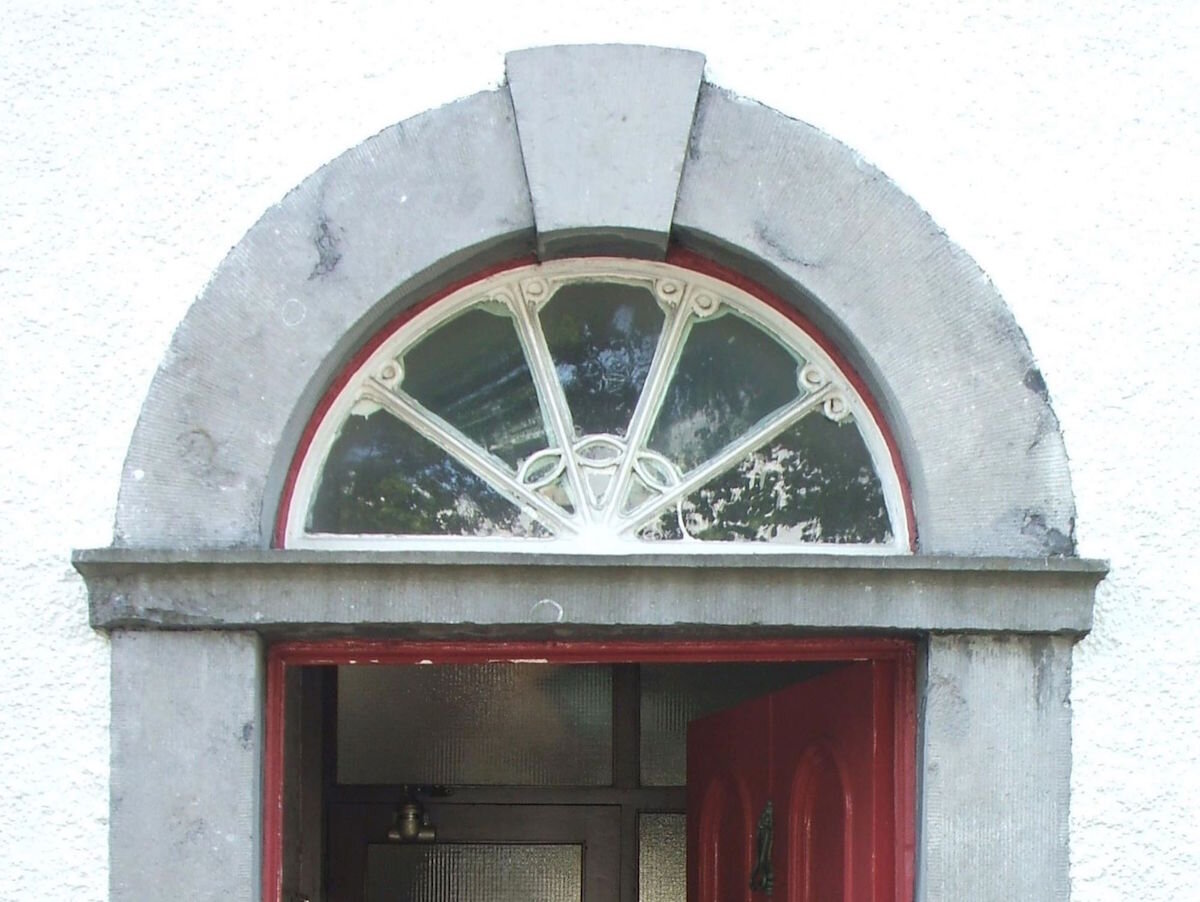
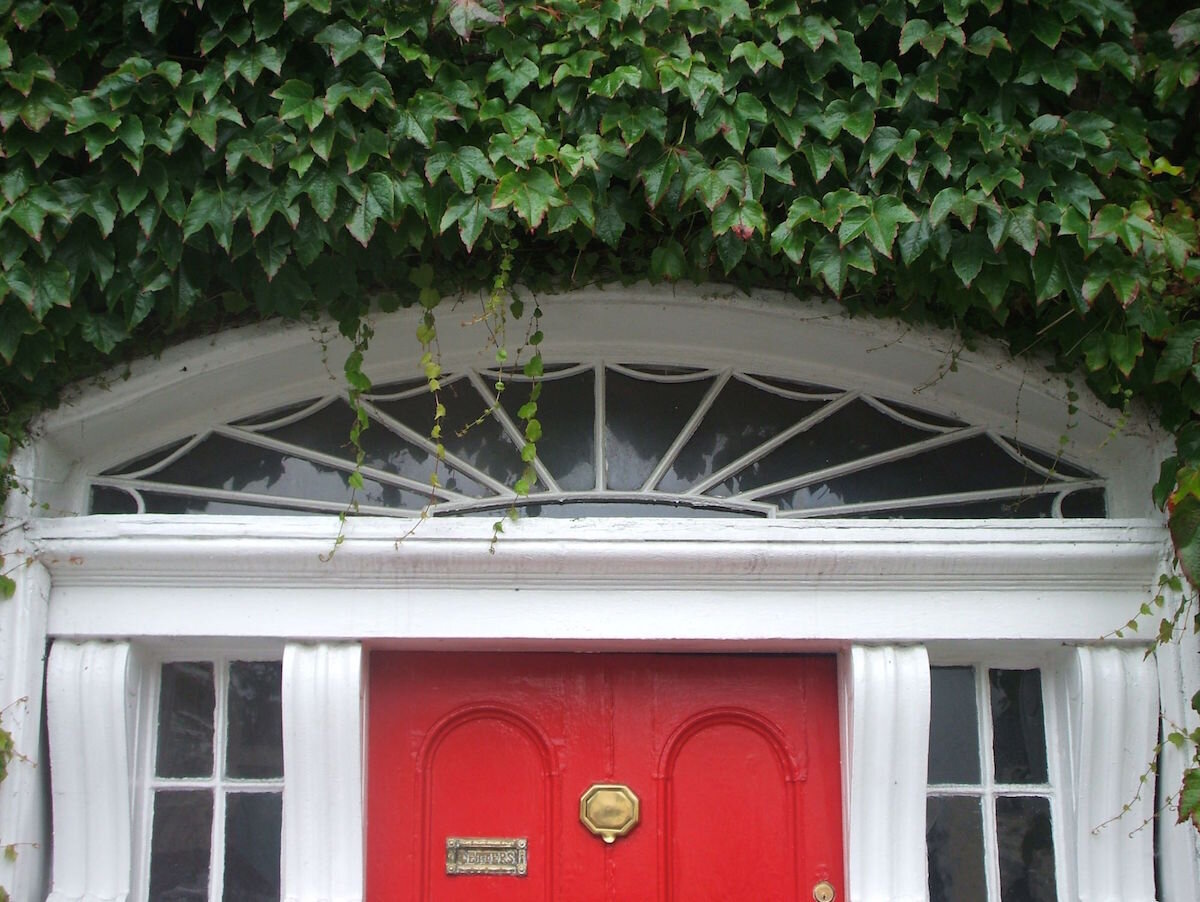
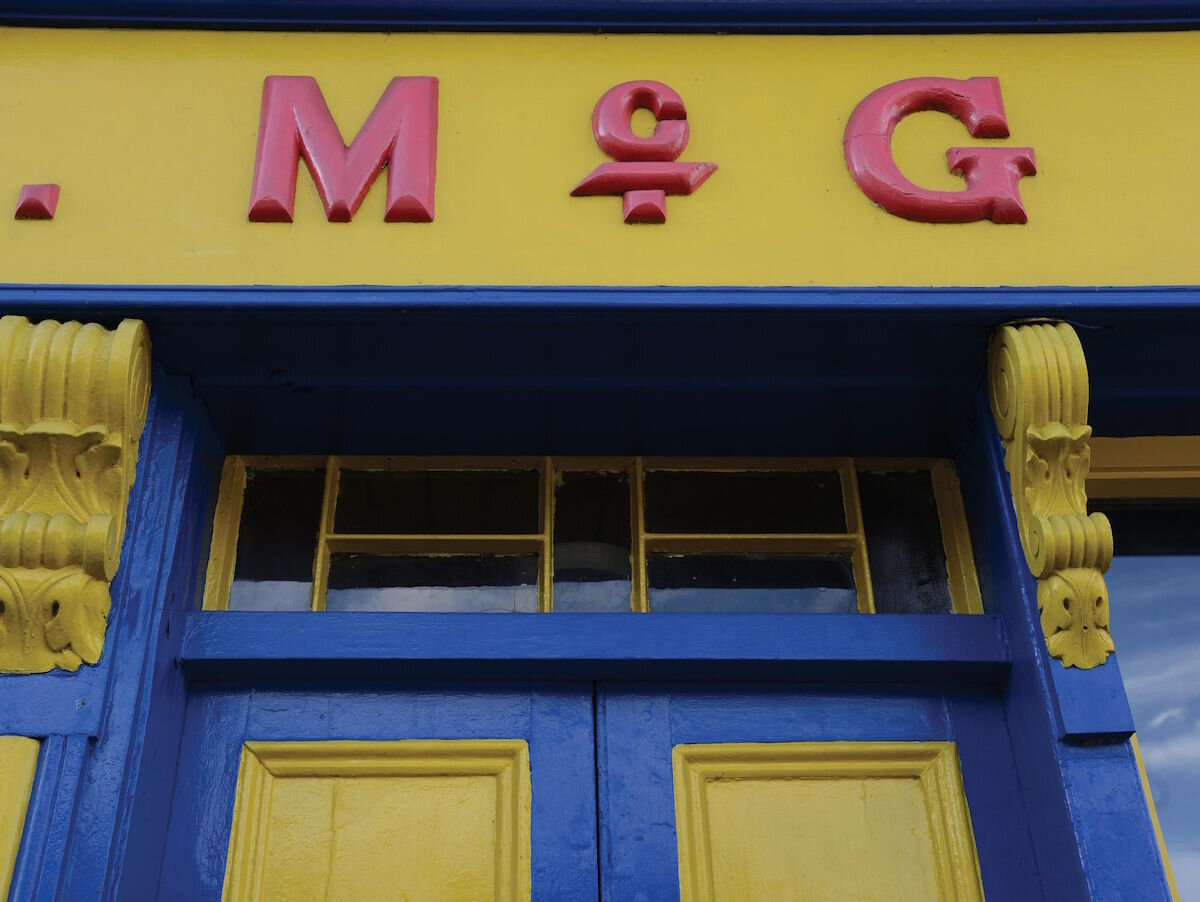
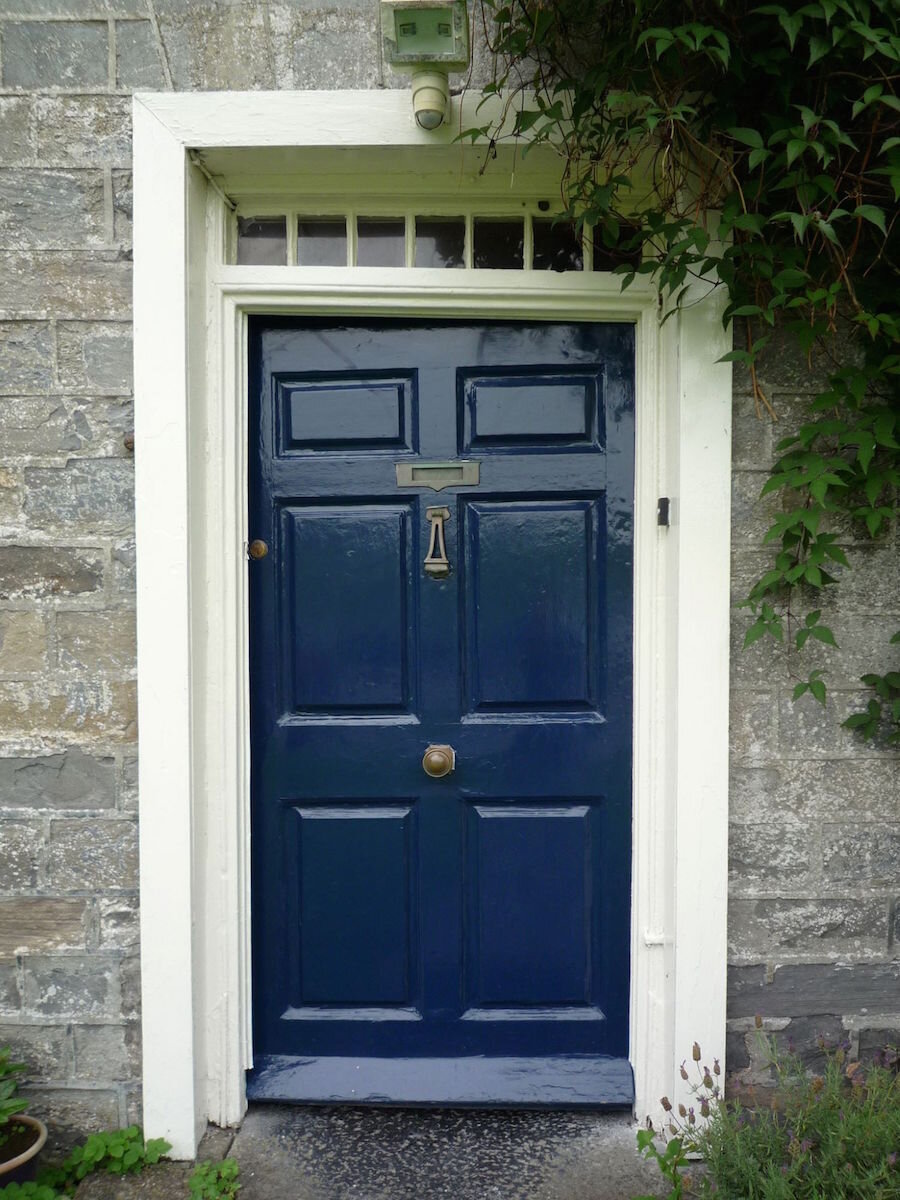
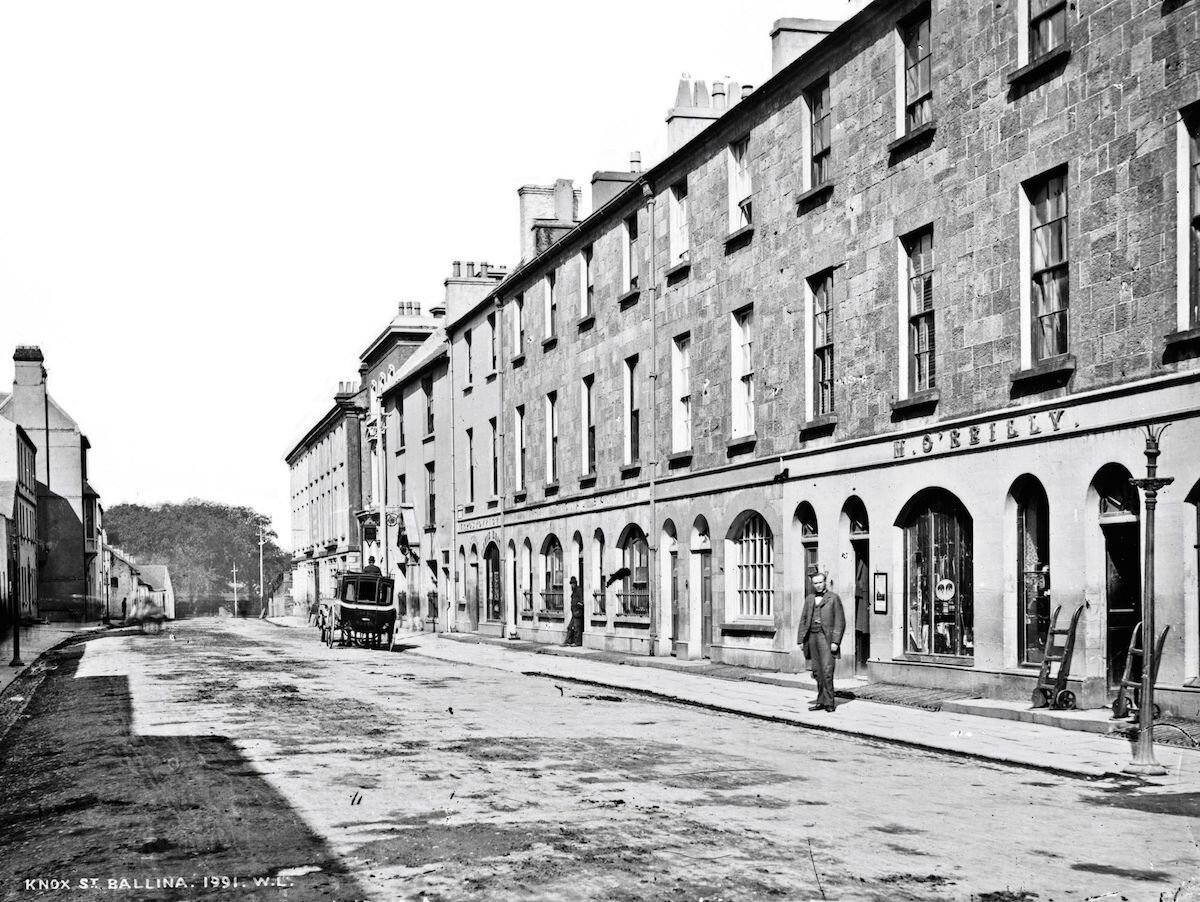
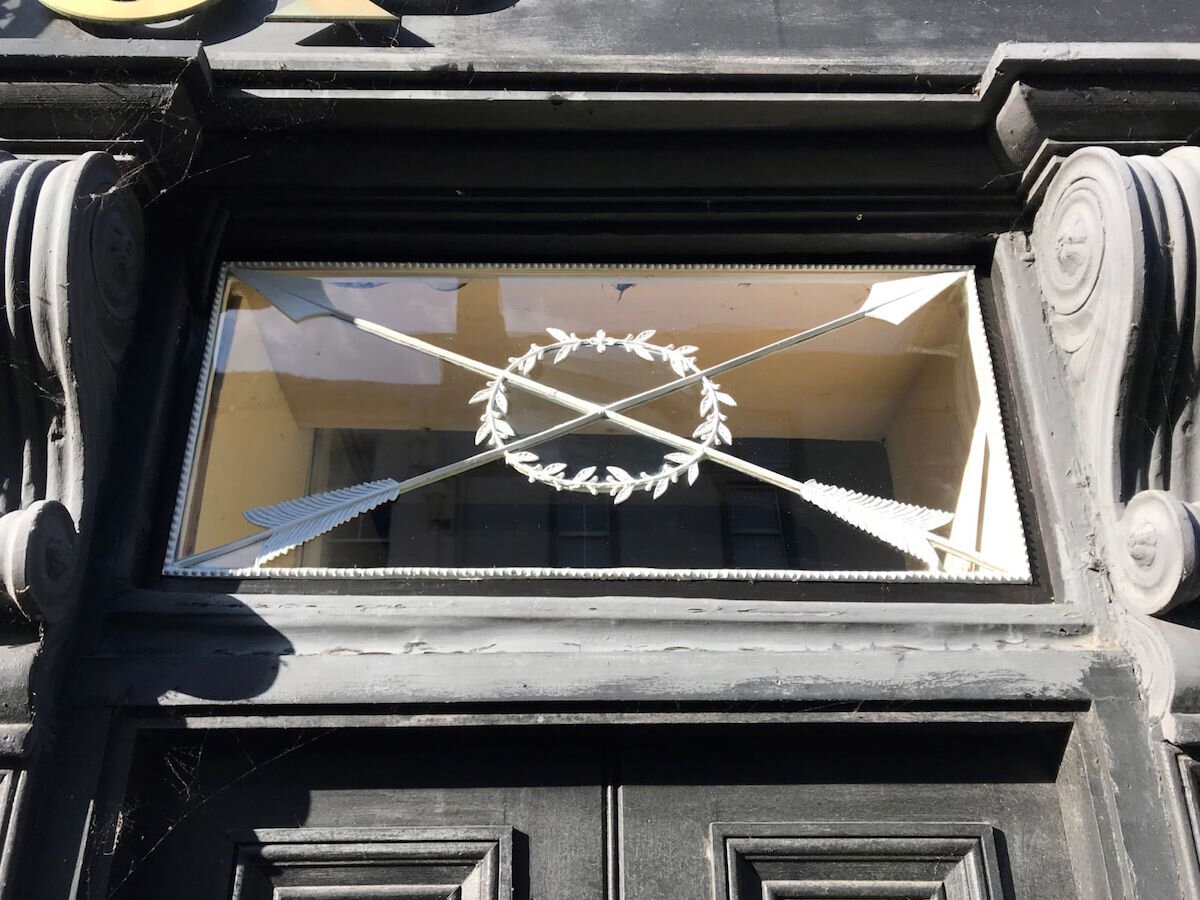
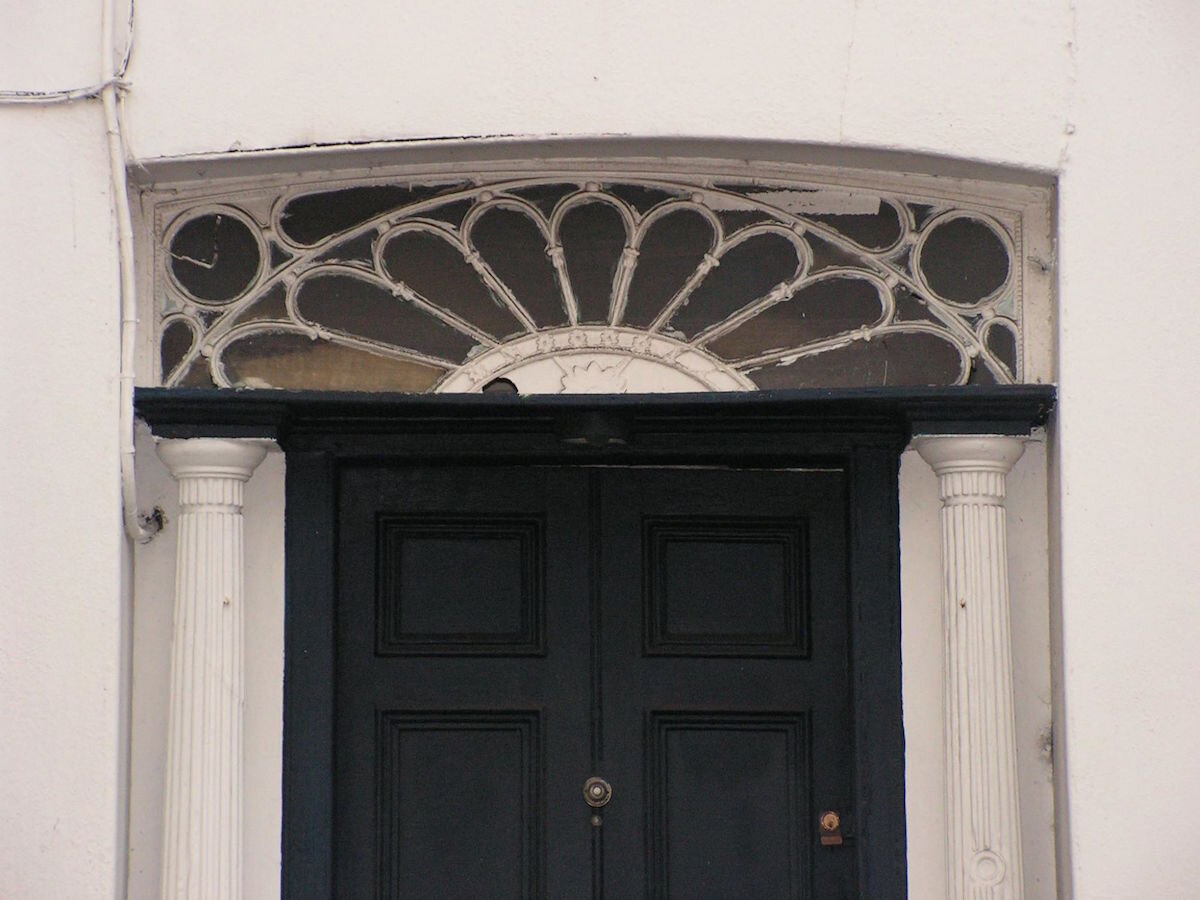
We will start our tour of County Mayo with a circuit of interesting rural fanlights and then go on a sweep of four towns. As this is a virtual tour, we are free to meander at will, starting at Ballinrobe near the border with County Galway and working our way north through Castlebar and Westport to Ballina.
The mid-nineteenth century Curraghmore, near Lough Mask in the south of the county, has a very unusual tall rectangular fanlight with the most basic rounded margins and sidelights, in a pared-back modernist ensemble reminiscent of the 1920s. Errew Monastery, east of Ballyhean, was built in 1840 to give religious instruction to poor children. It has a stone doorcase with narrow pointed sidelights and a unique fanlight design of Gothic pointed arches standing over semi-circles, possibly best described as "switch-track-meets-umbrella". No other fanlight of this pattern survives in Ireland.
Ballyhowly, just south of Knock, was very accurately drawn for the 19th-century Encumbered Estates sale catalogue, showing its distinctive canted entrance bay and block-and-start doorcase with spoked fanlight. Unfortunately the fanlight, door and sash windows are now gone. West of here, Ballinafad House (1827), near Balla, came to public attention two years ago in "The Great House Revival" which followed its conservation and restoration. Sheltered behind its very fine porch, a later addition which has some lovely glazing itself, the tripartite doorcase features an elaborate hub and spoke fanlight with a central band formed of groups of three circlets, tiny ionic capital-like scrolls at the band and border, and circlets around the hub. This elaborate and very elegant fanlight is repeated over the large window lighting the staircase hall.
Mallow Cottage, near Westport, has a lovely elliptically arched rectangular fanlight of five circles inside a border. It was once the home of nationalist MP William O'Brien (1852-1928) and his wife Sophie (1860-1960). O'Brien was from Mallow, County Cork, and renamed the house which was originally called Altamont Villa after the Marquess of Sligo of Westport House.
There are two very unusual doorway designs near Newport. Newport House has a rectangular fanlight with just two curves forming a large lens, a supremely pared-back design. The glebe house (1819) nearby has a striking, almost modernist doorcase with a pair of sweeping jambs projecting proud of the wall. This very dominant form is surmounted by an unusual cobweb design in which a middle band holds a series of circlets skewering the spokes – a detail that upstages the cobweb border. The eight-panel door is also very impressive.
The glebe house at Swinford, which strictly speaking is not a rural house, has a very simple hub and spoke fanlight. Of particular interest is that we know who designed the house and when: the architect was John Lynn (d. 1864) of Sligo and his drawings of 1819 are held by the Representative Church Body Library. Viewers who know the house will see that the door has been replaced and the sash window format differs from Mr Lynn's drawing.
The main doorway of Belleek Manor, near Ballina, is an extraordinarily creative Tudor-Gothic fantasy of the 1820s. It boasts one of the most elaborate fanlights in Ireland – a wonderful confection of Gothic-arched petal fans and wide, arcaded sidelights, with corner circles and teardrops.
There are two gorgeous cobweb fanlights at Knockglass House, north of Crossmolina, both set in segment-arched rectangular openings – one over the front door and a second between the front and back halls. Very unusually, Knockglass also has a third one, a simple spoked arch. To have three fanlights is highly unusual and so, surprisingly, is the ornate cobweb design in this format with corner circles. A short distance to the northwest is Millbrook. A lithograph from the Encumbered Estates sale catalogue shows the house, said to be from 1796, with original hub and spoke fanlight with middle band. The fanlight was lost when the façade or perhaps the whole building was reworked, and the house was renamed Owenmore.
Carrowmore House, a large farmhouse about halfway between Ballycastle and Killala in the north of the county, has a very unusual peacock fanlight, perhaps the only one in County Mayo. This is a design rarely seen outside Dublin.
Our tour of Ballinrobe begins at Saint Mary's Church (1815-8), sheltered in leafy grounds behind Main Street, which is now the home of Ballinrobe Library so its switch-track Gothic-arched fanlight is easily accessible to all. On the opposite side of Main Street, but set back like its mother church, is the Church of Ireland glebe house of 1813. Our photograph is by Robert French (1841-1917) and it shows that the spoked fanlight was constructed according to the original drawings for the house which are held by the Representative Church Body Library. Robe Villa (1739-41), a fine house over the bridge on the Castlebar Road, has long been vacant but has recently benefitted from grant-funded conservation works to its roof and windows. Two photographs from the Irish Architectural Archive, taken by Hugh Doran in 1980, show its doorcase in happier times and the ornate plasterwork decorating the interior of the fanlight.
There are few surviving fanlights in Castlebar but the expansive doorway and simple spoked elliptical fanlight of Burleigh House, Ellison Street, is deserving of mention. An internal border of cobwebs is just about visible from the street. Castlebar Infantry Barracks features a fine complex of officers' quarters, soldiers' quarters, and related buildings, but only one original fanlight survives and it is of the simplest possible design: two vertical bars. This is not untypical of barrack fanlights – the other usual design is the basic hub and spoke pattern. Upper Chapel Street is home to a pair of fine houses, including a former constabulary barrack, which has a finely detailed Classical limestone doorcase with spoked fanlight. This street also hosts a cobweb fanlight in a most elaborate Georgian Revival doorway at Saint Gerald's Technical School, built in 1909, a very late date for a fanlight.
Westport is renowned for its architectural heritage and fanlights are an important part of its special character. Starting at the north end of the town, Westport Glebe, Newport Road, has a very elegant petal fanlight over an elliptical tripartite doorcase. There are many noteworthy fanlights along both of the town's tree-lined malls. The Doric portico of the Old Railway Hotel, at the west end of North Mall, shelters a simple cobweb fanlight within a fine limestone doorcase. There are also spoked fanlights in rusticated arcades along the two-storey wings. The crowning glory of North Mall is the tripartite doorcase and ornate banded cobweb fanlight of the Westport House dower house. This Georgian treasure is now home to Westport Credit Union and the fanlight and sidelights were repaired in 2017 by Glasshaus Studios, grant-aided by the Department of Culture, Heritage and the Gaeltacht. Bridge House, a little further along North Mall has also benefited from grant funds; it has a simple spoked fan.
Thomond House, South Mall, hosts a cobweb fanlight with a large hub and its twin is found two doors further on. The parochial house on one side of Saint Mary's Catholic Church has a cobweb in a shallow arch while its partner, the presbytery on the other side of the church, has more unusual fanlight detailing: each of the four spokes is terminated by tiny scrolls – reminiscent of Ballinafad House – and a necklace of lenses forming the hub. Another grand elliptical-arched tripartite doorcase, but one with much simpler cobweb fan, is found on The Octagon beside the former market house; its rectilinear hub is unusual. McGing's, High Street, has a nice pair of geometric rectangles, an elaborate version of a fanlight pattern often found over shop doors. Sean Malone, just along the street, has a more typical simple mouthorgan fanlight. While Westport House itself, like many of the grandest country houses, does not have a fanlit doorcase, one door of Rusheen Lodge within the estate is decorated with a seven-pane mouthorgan. It manages to be splendidly lopsided without losing its dignity.
Ballina, our final destination, is another town rich in fanlights. Starting at the centre of town, the fine terrace of ashlar-faced houses on the east side of Pearse Street, near the former Moy Hotel, has a series of simple cobweb fanlights with double hubs as part of a formal arcaded shopfront design. Two houses further north were built in 1846 and have matching internal cobweb fanlights which are visible when the street doors are open. A short stroll across the street is the marvellous shopfront of The Fashion Shop with its very unusual "crossed arrows" rectangular fanlight. The fanlight was repaired in 2019 by Glasshaus with grant aid. The former Moy Club at the west end of Dillon Terrace has a bracketed doorcase featuring a camber-headed fanlight with banded spokes and no hub. The neighbouring houses on Dillon Terrace have a series of simple cobwebs in very plain doorcases. Two muscular stone doorcases at Victoria Terrace, on the west bank of the River Moy, have fanlights filled with a single circle. 1 Abbey Street, on the east side of the river, has a decorative petal fanlight within an arched rectangle reminiscent of Knockglass House – and there is another inside the house.
There are many more fanlights in County Mayo, some simple, some spectacular, which we have not been able to include on this virtual tour but you can look up your favourite, or discover a new favourite, on the NIAH website: https://www.buildingsofireland.ie/buildings-search/


